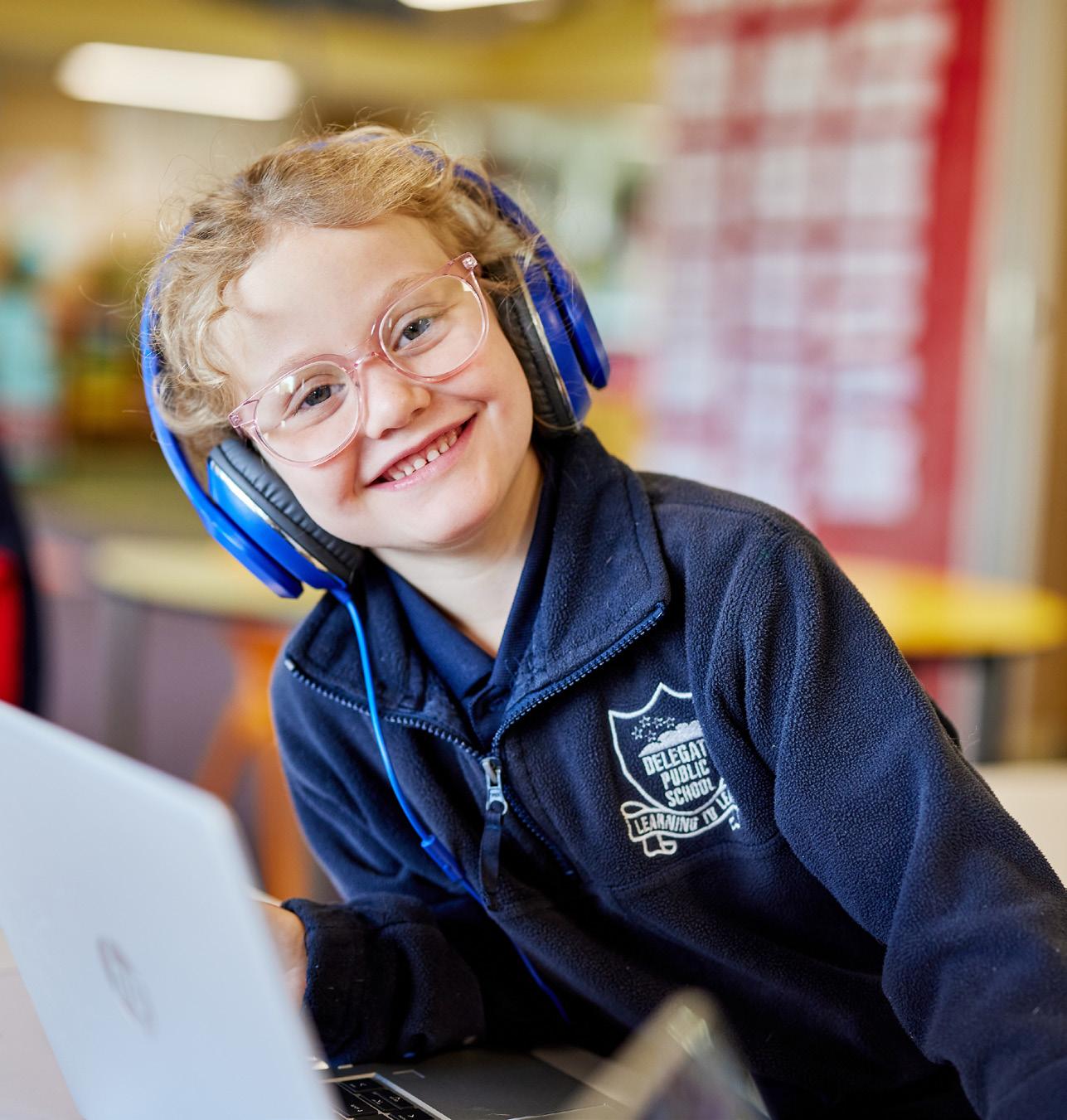
Supporting neurodivergent learners
Writing in Secondary Developing media literacy
... more inside
Volume 43 Issue 2

Published by the NSW Department of Education, Scan is an open access online journal, delivered quarterly. Scan is a leading educational resource that brings innovative change to the lives and learning of 21st century educators and students. Scan informs teachers’ practice by encouraging engagement with a wide range of articles, including peer reviewed research, to enhance school and student outcomes across NSW, Australia and beyond. The journal aims to leave teachers inspired, equipped and empowered, and students prepared to maximise their individual talents and capabilities.
4
Writing in Secondary –learning to write and writing to learn in Stages 4 and 5
Dr Mark Howie, Caitlin Morton and Dr Angelina Leonello outline the Writing in Secondary project and reflect on the research findings of the pilot program.
13
Media literacy – the need for equitable opportunities
Drawing on findings from her national survey, Associate Professor Tanya Notley considers the need to provide students with sufficient and equitable opportunities to develop news literacy.
18
Neuro-affirming approaches to supporting autistic students
Katie Koullas, CEO of Yellow Ladybugs, shares insights into supporting autistic or neurodivergent students in the classroom and beyond.
22
Nurturing allyship among peers of neurodivergent learners –practical tips from I CAN
Chris Varney, CEO of I CAN Network, outlines practical strategies to support neurodivergent students, nurture allyship and create inclusive school environments.
28
Celebrating neurodiversity at Smith’s Hill High School
Daniel Jones and Brodie Jones explain how Neurodiversity Celebration Week activities at Smith’s Hill High School create opportunities to increase wellbeing within the school community.
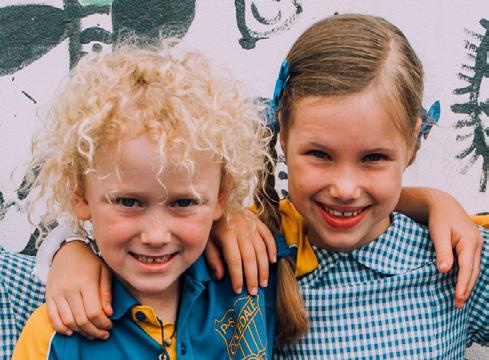
22
Contents

Want more innovative ideas and inspiration for learning and teaching?
35
Term 2 Premier’s Reading Challenge booklist update – graphic novels and illustrated chapter books
Jade Arnold introduces new additions to the PRC booklist and describes how graphic novels and illustrated chapter books support reading success and engagement.
40
51
From boys to men – using literature circles to explore Year 8 boys’ perceptions of masculinity
Pooja Mathur shares her action research into the use of literature to encourage students’ exploration and expansion of their perceptions of masculinity.
Writer biographies
Browse our past issues – a compendium of educational ideas to enhance your teaching practice.
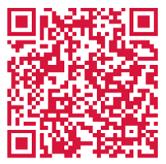
Copyright: The material in this publication is subject to copyright under the Copyright Act 1968 (Cth), and is owned by or licenced to the State of New South Wales through the Department of Education (the Department). Material published in Scan covers and other third party content in Scan are reproduced with permission, where applicable. Apart from uses in accordance with the Creative Commons licence (below), permission must be sought from editor.scan@det.nsw.edu.au prior to any (other) use.
Creative Commons: The material in this publication is licensed under CC-BY-NC-ND 4.0 and may be printed or downloaded without alteration or abridgment and must retain attribution of the source. The user shall not sell, hire or otherwise derive revenue from copies of the material.

The views expressed in these articles are solely those of the authors and do not represent the views of the NSW Department of Education. Links to external sites: Links within Scan are provided with the intention of increasing the information available to our readers. The NSW Department of Education has no control over linked websites, and is not responsible for the views, opinions, standards or information expressed on linked websites. The provision of a link does not imply that the NSW Department of Education endorses those websites or the people or companies who own them, and vice versa. Please refer to www.nsw.gov.au/disclaimer#links-to-external-sites for a comprehensive description of the NSW Government’s policy regarding links to external sites.
The appearance of advertising on, in or in connection with the NSW Department of Education, and the Scan publication, does not imply any endorsement of the advertised company or product.
© 2024 State of New South Wales (Department of Education). ISSN 2202-4557. SCIS 1547886.
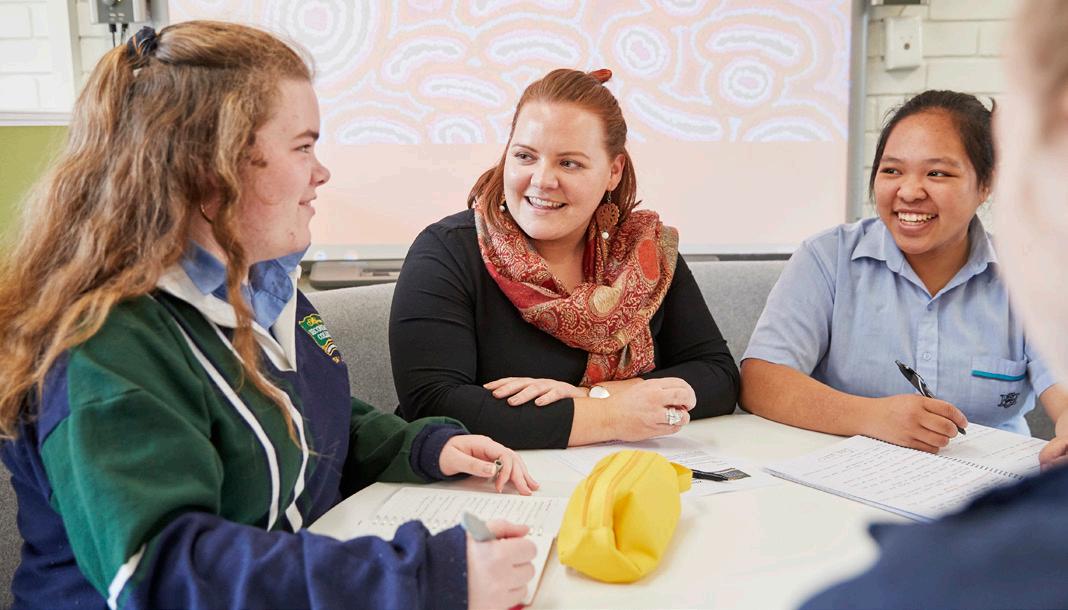
Writing in Secondary –learning to write and writing to learn in Stages
4 and 5
Dr Mark Howie, Caitlin Morton and Dr Angelina Leonello outline the Writing in Secondary project and reflect on the research findings of the pilot program.


Introduction

Dr Mark Howie
Leader, Writing in Secondary, NSW Department of Education
Caitlin Morton
Evaluation Lead, Quality Teaching Practice Evaluation and Data, NSW Department of Education
Dr Angelina Leonello
Evaluation Capacity Building Lead, Quality Teaching Practice Evaluation and Data, NSW Department of Education
Strengthening the teaching of writing in the secondary subject disciplines is a pressing imperative – one very much of the moment for our teachers. Changes underway to the NSW curriculum include the explicit inclusion of writing in syllabuses .
There is evidently much to be done if our students are to improve their writing. Research conducted in 2018 by the New South Wales Educational Standards Authority (NESA) on the teaching
4 Scan Vol 43 Issue 2
of writing in NSW found that secondary teachers believe themselves to be ‘minimally prepared in all aspects of teaching writing’ (p 12), with relatively little time being given to the teaching of writing across secondary schooling, particularly for students in Stages 4 and 5.
Schools and teachers participating in the Writing in Secondary (staff only) (WiS) project are well-positioned for the changes in the NSW curriculum that address writing and writing instruction in subject areas other than English. The project also makes writing resources available to all secondary teachers in NSW public schools.
Writing in Secondary: background and pilot phase
WiS aims to lift academic writing in Stages 4 and 5 across the state, with a specific focus on equitable achievement of student outcomes. In a pilot phase in 2021–22, 20 schools participated in WiS. School-based instructional support from an expert teacher – a Curriculum Writing Specialist (CWS) – was established in each school. Evidence-informed resources and support materials were developed with an academic partner, Western Sydney University. These resources and materials were delivered through high impact professional learning (PL), an online resource hub (staff only), and the school-based instructional support of the CWS.
During the pilot phase, embedded and ongoing evaluation processes were established for WiS. The Quality Teaching Practice (QTP) Evaluation and Data team, working in conjunction with the academic partner (Gannon et al., 2023) developed notable
WiS has an equity-driven purpose in strengthening the teaching of writing. This is to develop and support a culture of writing in schools that challenges existing assumptions and reinforces high expectations about achievement for the full range of students.
Schools and teachers participating in the Writing in Secondary project are wellpositioned for the changes in the NSW curriculum that address writing and writing instruction in subject areas other than English.
insights on the positive impact of the project for students’ writing development.
In summary:
• Students’ ability to create texts and use grammar significantly increased after the introduction of WiS PL-informed explicit teaching of writing. Students reported that they felt more confident as writers.
• Teachers reported being more confident as writers and writing teachers. They valued the professional learning developed and delivered by WiS, and the WiS resources they were able to draw upon in strengthening their teaching. They indicated that they would share knowledge with other teachers in their schools.
• Principals reported seeing evidence in their schools that WiS was leading to improved learning outcomes.
• Specialist instructional support, as provided by the CWS placed in each school, was critical to the translation of WiS PL to improved practice in the teaching of writing.
In 2022 an example of success was that students demonstrated higher progression levels for the National Literacy Learning Progression sub-element of Creating texts over the course of the year, with a statistically significant increase following explicit teaching (Figure 1).
In Figure 1, the red column on each graph represents the median. The blue box draws attention to the number of students who demonstrated the 3 highest Creating texts levels. There were 712 students included in this analysis.
5 Scan Vol 43 Issue 2

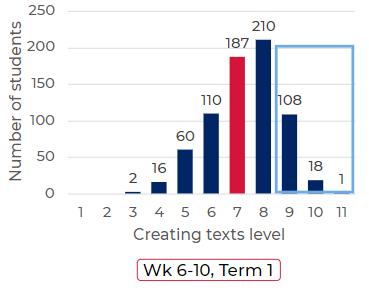



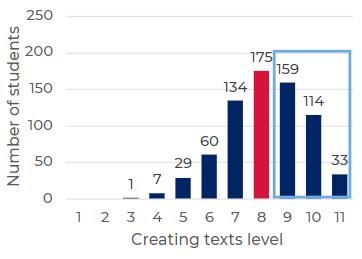
By 2023, WiS was well-placed to extend its reach and influence on teaching practice, knowing that the results of the pilot phase affirmed:
• the quality and impact for teachers and students of the project’s conceptualisation, design, structures and processes
• the quality and impact of the PL and resources produced and delivered.
School networks in 2023–24
To extend the engagement of teachers with expert teacher writing specialists, WiS shifted to a collaborative network delivery model from 2023. In 2023–24, this model (Figure 2) brought together teachers from 42 schools in 14 networks across the state. Each network is formed around an expert teacher in the role of writing instructional leader – the Network Writing Specialist (NWS) – and their school. A WiS network typically constitutes 3 schools. Each NWS has remained in their own school to work on strengthening the teaching of writing, retaining a 0.2 above establishment teaching load and staying connected to the classroom. At the same time, the NWS also offers instructional leadership and support for the teaching of writing in their network schools, including capacity building for a school-based instructional specialist, the School Writing Specialist (SWS).
Expert teachers eligible to take on the role of NWS and participating schools were identified from data sets focused on teacher impact on student results, regardless of context. The selection process was also informed by consultation with Executive Directors Public Schools, Directors Educational Leadership, and principals. A merit selection process followed for the teachers, and an invitation to participate in the project was extended to the schools. Participating schools, including those with a NWS, received funding support to facilitate the implementation of the SWS role and to assist with teachers’ participation in WiS professional learning.
The WiS network formations enable instructional support in schools across eight directorates. The networks have a common purpose: leveraging specialist instructional support to strengthen the teaching of writing in years 7–10 for improved student learning outcomes.
6 Scan Vol 43 Issue 2
Figure 1: Movement in demonstrated student writing progress 2022
This unifying and motivating purpose is expressed through:
• a set of common principles and values
• a research based conceptual framework for the explicit teaching of writing
• a commitment to equity
• frameworks for implementation, incorporating markers of progress and success, processes for self-evaluation, and guidance for sustaining implementation in schools over time
• a focus on developing and sharing new knowledge, resources, and practice.
The WiS networks of schools are a driver of heightened collaborative endeavour, both in and between schools. An effective network of schools will optimise the outreach of specialised instructional support in strengthening the teaching of writing 7–10 for improved student learning outcomes.
WiS has an equity-driven purpose in strengthening the teaching of writing. This is to develop and support a culture of writing in schools that challenges existing assumptions and reinforces high expectations about achievement for the full range of students. Teachers’ pedagogical knowledge and capacity in teaching writing have been identified
as barriers to higher levels of achievement by many students (NESA, 2018, PDF 780 KB).
WiS seeks to address these barriers for students from:
• different schools – by location and levels of socio-economic disadvantage
• identified social groups – groups shown to be disadvantaged by the education system in a range of ways.
Evaluation results in 2023 indicated very positive results. To support the scaling of WiS, the 2023 evaluation aimed to measure progress towards improved student writing ability across contexts, including different equity groups. While continuing to monitor the quality of the professional learning, the evaluation dived deeper into the support and resources provided through the network delivery model and sought to understand how teachers in network and non-network schools engaged with and implemented WiS practices in their contexts. Through collecting and analysing diverse data from surveys, interviews with teachers and NWS, school case studies, student work sample data and focus groups with students, the 2023 evaluation identified a range of successes enjoyed by WiS participants.
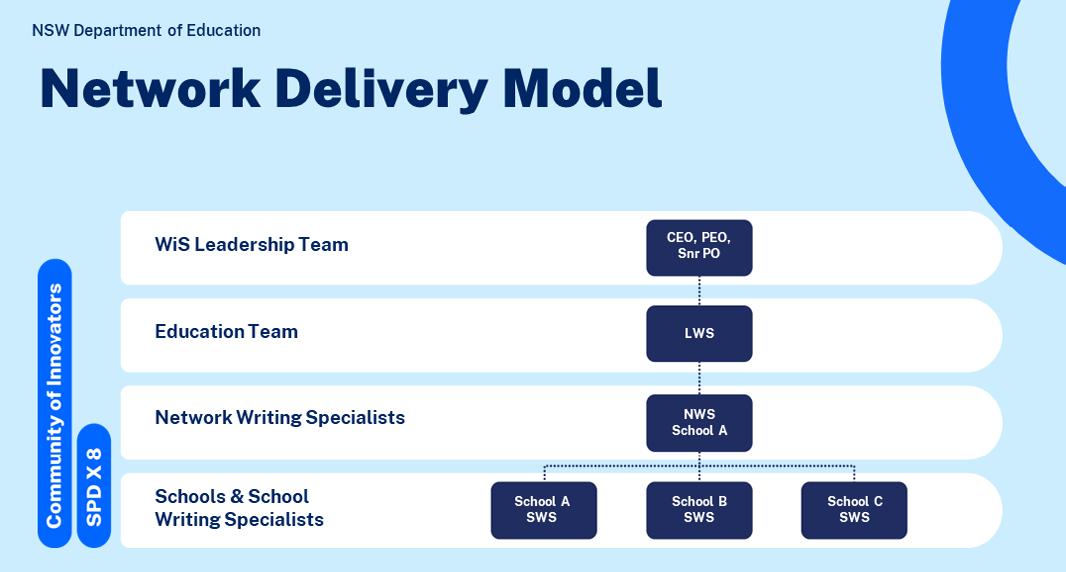
7 Scan Vol 43 Issue 2
Figure 2: WiS network delivery model
Some key successes included:
• Users including teachers, school leaders and educational support staff found the WiS Resource Hub (staff only) usable, time saving, relevant, and impactful. They told us that they were using resources for planning, in classrooms, for improving their understanding of writing, and that they saw how the resources would benefit their students. Additionally, teachers using the WiS Resource Hub noted the resources had supported them in this time of curriculum change.
• NWS offered diverse support, enjoyed their roles, saw steady growth in their networks of schools, and felt supported by school leaders. They enabled the schools in their networks to implement WiS in ways suitable for their local school contexts, including by developing the capacity of SWS to drive WiS in schools.
• Given that the scaled version of WiS initiated in 2023 involved NWS supporting 3–4 schools, including their own, the 2023 student work sample analysis questioned whether students in the network specialists’ own schools demonstrated different trends in writing ability compared to those in other schools NWS supported. It was found that all students showed significant improvement in Creating texts and Grammar after the introduction of WiS-informed explicit teaching of writing, regardless of whether the NWS was based at their school. This finding supports the effectiveness of the network delivery model.
• Teachers noticed changes in their practice and confidence as writers and writing teachers, evidenced by a range of qualitative work and responses to self-efficacy surveys. School case studies revealed that the pedagogical shifts experienced by teachers were seen by teachers and school leaders to have been ‘transformative’.
• Schools adapted strategies for implementing WiS to suit their contexts and local school goals, with principals creating the conditions for effective implementation.
A range of implementation strategies were identified by school case studies, which showed that WiS approaches were adaptable and seen as effective across a range of contexts.
• Student focus groups showed that students felt more confident about writing following the introduction of WiS-informed teaching strategies in the classroom and that they recognised the impact of those strategies on their writing ability. Students told us that teachers used various methods to help improve their writing and provided individualised support.
• Teachers and school leaders noticed changes in students. Teachers reported remarkable results after incorporating knowledge and skills gained from the professional learning into their classrooms. Those changes were observed in students from various backgrounds and contexts. For example, teachers and school leaders noticed students with low writing ability became more engaged with writing and showed signs of improvement.
• The analysis of student work samples in 2023 found that the average level achieved by students on the National Literacy Learning Progression and the number of students achieving high levels increased over the year in all measured areas but increased to a greater extent after the introduction of WiS-informed explicit teaching of writing in the classroom. Significant lifts in writing ability were observed across various groups, including equity groups.
... the average level achieved by students on the National Literacy Learning Progression and the number of students achieving high levels increased over the year in all measured areas but increased to a greater extent after the introduction of WiS-informed explicit teaching of writing in the classroom.
8 Scan Vol 43 Issue 2
The WiS Conceptual Framework
The evidence-based WiS Conceptual Framework (staff only) (Figure 3) guides all work in the WiS project. It is foundational to the capacity building of writing instructional leaders and specialists, the design and delivery of WiS PL and resources, and the framework informing goal setting and selfreflection on progress within participating schools and their respective networks.
In summary, these are the overarching goals captured in the framework.
• There is a whole school understanding of the role that writing plays in learning that is reflected in school and faculty planning and practices.
• The writing process is taught as an engagement between two interacting sub-processes: learning to write (craft) and writing to learn (subject content).
• A culture of writing is highly valued: the practices of this culture build the self-efficacy of teachers and students.
• A shared metalanguage for thinking and communicating about writing is commonly used by teachers and students.
Strengthening the teaching of writing is complex and challenging work, being multi-faceted, multi-dimensional and multirelational in nature.
• Documentation, practices and processes enable and support a sustained and ongoing focus on the following in the teaching of writing:
৽ explicit teaching of text forms and features
৽ authentic connections being made between audience, purpose and form
৽ explicit teaching of language knowledge and skills (including vocabulary and grammar) at whole text, paragraph, sentence, word/word group levels
৽ skills in spelling, punctuation and paragraphing that are developed in the context of the writing being completed
৽ thoughtful, effective and explainable uses of grammar by students for meaning, effect and affect
৽ the rhetorical and stylistic elements of any written piece.
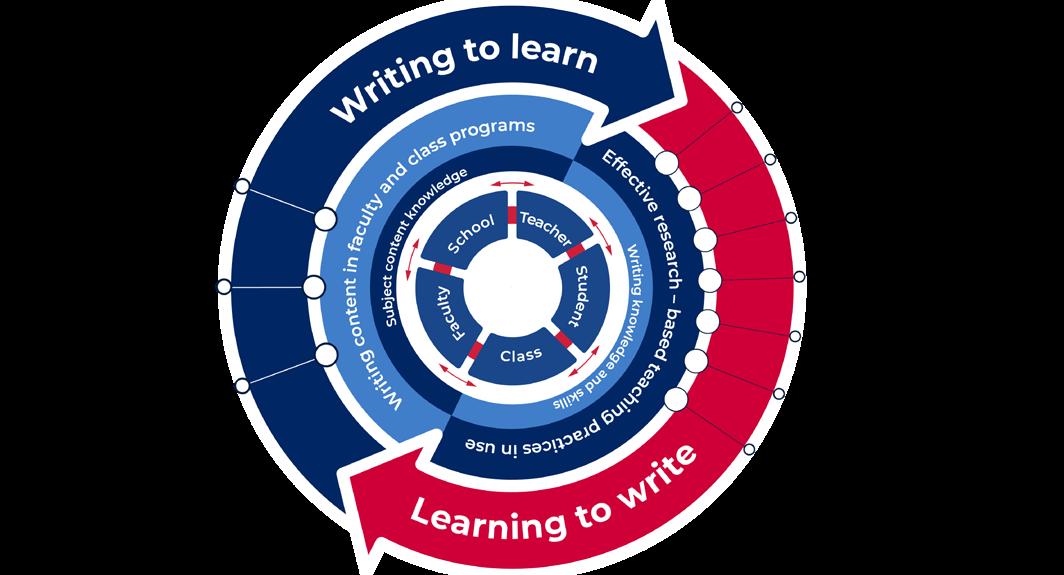
9 Scan Vol 43 Issue 2
Figure 3: WiS Conceptual Framework
Strengthening the teaching of writing is complex and challenging work, being multi-faceted, multidimensional and multi-relational in nature. Key enablers of its success are being recognised by school leaders, teachers and students engaging with WiS.
School planning and organisation is in place to ensure the provision of professional learning that is ongoing and purposeful, and which includes specific opportunities to build the capacity of all teachers.
“[WiS] is now the benchmark for a lot of our literacy and numeracy interventions because of the profile that it has within the school. So, it’s now embedded within our strategic improvement plan under Direction 1… well and truly on its way to being embedded within the school culture of embracing writing as a whole school business.” Principal
Faculty organisation has been established to support a unified focus on learning to write (craft) and writing to learn (content). This includes faculty opportunities to apply professional learning to planning, programming and assessment, and for teachers to collaboratively test out, evaluate and then apply strategies that will be consistently used.
“It’s been really cool seeing [teachers’] mindset change – in it’s not just about my content. It’s not just about asking the kids to write something and here’s a scaffold. It’s being explicit in the way that we teach it, explicit in the way that we put it in our instructions.” Head Teacher
Teachers are actively engaging with the strategies and resources presented in WiS PL and made available on the WiS Resource Hub (staff only), and then purposefully implementing these in their programming and teaching. A crucial step in building a classroom culture of improvement for stronger writing is for teachers to evaluate the impact of changed practices – both for themselves and for their students.
“I would say that this has just changed my teaching practice so made me so much more aware of things … I still did model responses and things like that in the past, but I wouldn’t be explicit in what I was doing.” Teacher
Students are learning and demonstrating a range of strategies that work in conjunction with their subject content learning to address the writing expectations of their subject areas.
“I was kind of confident, but I’m a lot more confident now, because I used to think it’s more about what you write and not how you write it.”
Year 8 student
The WiS conceptual framework sets the foundations for the explicit teaching of writing. Its elements, which structure and inform the learner journey for teachers participating in WiS PL, are congruent with the guiding principles and strategies outlined and promoted for explicit teaching in NSW public schools (NSW Department of Education, 2024).
WiS and explicit teaching
As a practical elaboration of the WiS conceptual framework and the professional learning teachers have undertaken, The WiS Planner: write to learn, learn to write (staff only) (PDF 112 KB) supports a recursive teaching and learning cycle. It enables teachers to plan explicit teaching, assessment and feedback practices for writing alongside content.
During their planning to teach writing (Figure 4), for a teacher to ask, ‘What do I want my students to learn?’, they must look outwards to the syllabus and other essential references, such as the faculty program and scope and sequence, in order to look ahead and establish the next phase of learning. At the same time, they must also look back and ask, ‘Where are my students now?’, to ascertain the ground that has been covered and the learning progress and achievements that have been made. Integral to such movement and activity are the explicit teaching principles of why students are learning something, what their learning goals are, how it connects to what they already know, and what they are expected to do.
In considering the written tasks they are planning to set for their students in any unit of work (Figure 4), teachers will move recursively in their planning between the following questions: ‘How will my students get here?’ and ‘How do I know when my students get there?’ Such questions must be grappled with to bring about the opportunities and time needed for students to show their
10 Scan Vol 43 Issue 2
understanding of what has been taught and to practise using the skills and knowledge they have learnt. In their decision making, teachers will necessarily draw on, and bring together, explicit teaching strategies to optimise student learning through chunking and sequencing learning and the gradual release of responsibility. The former is instantiated in the WiS PL through the focus on strategies for building the (content) field knowledge. For example, supported reading and note taking, moving to strategies for the explicit teaching of textual forms and features, and elements of language and grammar needed to write about this content. Here the gradual release of responsibility becomes the lodestone for teachers and students. To this end, key strategies promoted by WiS include the sequencing of modelling, joint construction and independent construction in lesson plans and activities. The recursive nature of the teaching and learning cycle being used for the teaching of writing, as represented in the Writing in Secondary planner (Figure 4), encourages and supports teachers, guided by student understanding, to move through and between iterations of modelling, guided practice and independent practice as required for the whole class, groups of students and individuals.
Support for teachers in establishing writing conversations as normalised classroom practice is a focus for WiS.
High quality feedback is important to writers in the different stages of the writing process. When thinking and reflecting about their writing, and then discussing these thoughts and reflections with others, students more fully develop as writers. Writing conversations provide an opportunity to embed formative assessment in supportive classroom routines for writing practice. They enable teachers to monitor progress and give feedback for improvement at key points as the student writer moves through the different stages of the writing process, from developing an idea for a written piece to its submission or publication. When conferring with others in focussed peerto-peer conversations, students will learn self and peer-evaluation techniques. They will have opportunities to ask questions to clarify and build understanding, and to receive clear, timely and effective feedback.

11 Scan Vol 43 Issue 2
Figure 4: Writing in Secondary planner. (View a larger version via the WiS Resource Hub [staff only].)
The essential focus of a writing conversation should be to enable meaningful discussion about the relationship between the choices (relating to text forms and features, language, grammar and elements of style) made by the writer and the intended rhetorical effect – the eliciting of a desired response from the reader (Myhill et al., 2020). With this focus, a dialogue can follow, addressing two key concerns: ‘What has been done and why?’ and ‘What could be done better and how?’.
The metacognitive ‘payoff’ for student writers from conferring with others about their writing is indubitable. Research (Australian Education Research Organisation [AERO], 2022) indicates the significant positive effects of building students’ capacity in reviewing and providing feedback on their peers’ writing and providing them with instruction in the qualities of effective feedback, with gradual release of responsibility. Support for teachers in establishing writing conversations as normalised classroom practice is a focus for WiS. In development are resources and professional learning for teachers in this area.
Conclusion
As a large public education system, we are committed to improvement and success for our students, teachers and schools. Strengthening the explicit teaching of writing in our secondary schools is essential to this commitment. As NESA has emphasised in the context of curriculum change in this state, writing remains ‘the principle means by which students both learn and demonstrate what they have learned’ (NESA, 2018, p 3). So it is, that the teaching of writing provides a significant focal point for bringing secondary teachers together in support of Our Plan for NSW Public Education (PDF 16.9 KB) (NSW Department of Education, 2023). It provides an empowering space for teachers to be learning and working collaboratively in delivering high-quality and equitable education for all students. WiS is having an impact in this area, supporting schools in developing a whole school approach to teaching writing 7–10 in a time of curriculum change, building the confidence and capacity of teachers in the explicit teaching of writing and demonstrably improving student learning.
References
Australian Education Research Organisation (AERO). (2022). Writing and writing instruction: an overview of the literature
Gannon, S., Carroll, K., Curry, C., Jacobs, R., Mackenzie, E. & Dove, J. (2023). Writing in secondary academic partners. Western Sydney University. https://doi.org/10.26183/8e7j-1n10
Myhill, D., Newman, R. & Watson, A. (2020). Going meta: dialogic talk in the writing classroom. Australian Journal of Language and Literacy, 43 (1), 5–16. https://doi.org/10.1007/ BF03652040
NSW Department of Education. (2023). Our Plan for NSW Public Education: transforming lives through learning
NSW Department of Education. (2024). Explicit teaching in NSW public schools (PDF 989 KB)
NSW Educational Standards Authority. (2018). Teaching writing: report of the thematic review of writing (PDF 780 KB)
How to cite: Howie, M., Morton, C. and Leonello, A. (2024). Writing in Secondary – learning to write and writing to learn in Stages 4 and 5. Scan, 43(2), 4–12.
12 Scan Vol 43 Issue 2

Media literacy – the need for equitable opportunities
 Tanya Notley Associate Professor, University of Western Sydney
Tanya Notley Associate Professor, University of Western Sydney
Media literacy researcher, Tanya Notley, draws on findings from her national survey to consider if students are being provided with sufficient and equitable opportunities to develop their news literacy.
Young Australians and the news
Citizens need to have the requisite skills, knowledge and capabilities to be able to use news media to engage with politics and world events. In June 2023, our nationally representative survey asked 1,064 children and teens (aged 8 to 16 years old) from around Australia how they access and consume news media (Notley et al., 2023).This repeated earlier surveys conducted in 2017 (Notley et al., 2017, PDF 2.8 MB) and 2020 (Notley et al., 2020, PDF 422 KB).
When asked about the news they accessed yesterday (see Figure 1), most young people in the survey group (83%) said they had received it from at least one source, while one third (33%) used three or more sources. The survey also found that, while less than half (43%) of young people surveyed think getting news is important to them (a drop from previous years), most (65%) believed that getting news made them feel smart or knowledgeable.
13 Scan Vol 43 Issue 2
News sources
We also asked young Australians where they prefer to get their news from (see Figure 2). Results indicated that family is the most preferred news source, mirroring the results from past surveys. However, the popularity of social media as a preferred news source has been increasing over time.
Family members remain the most trusted source of news for young people (93% trust their family to deliver them news), followed by teachers (87%). Fewer young people trust Australian news organisations to deliver them news (54%). This suggests that young people, especially children aged 8 to 12 years, look to teachers and parents to act as news filters and to help them decide what news they should engage with and trust. Our research also tells us that when young people become teenagers, they are more likely to access news independently and are far more likely to get news from social media (Notley
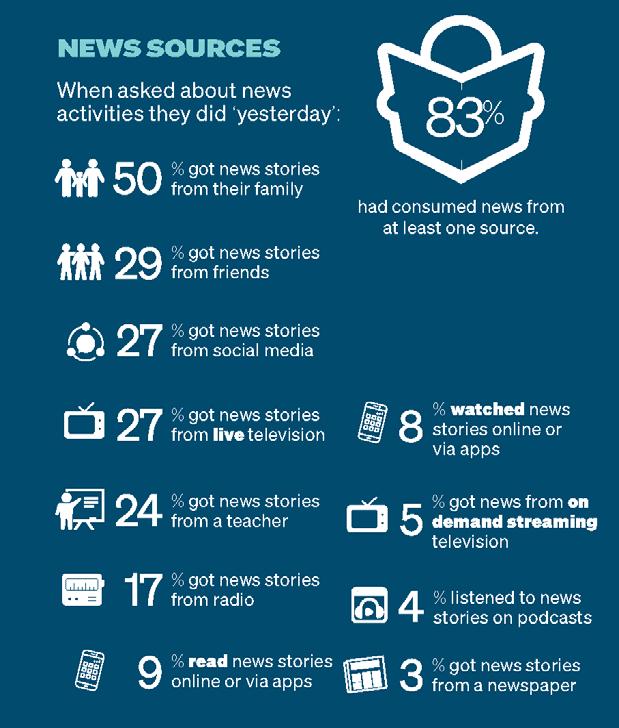
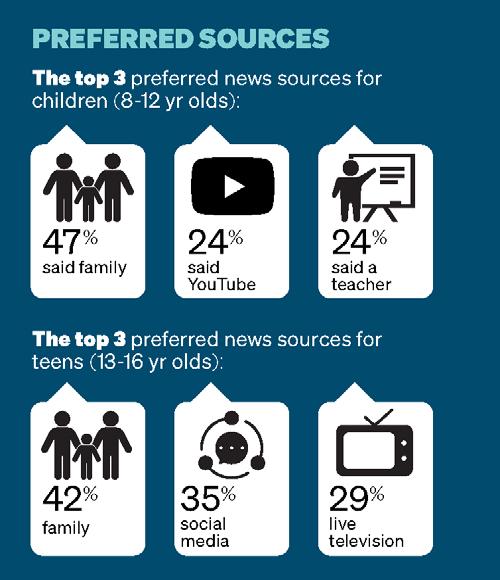
News engagement divides
Overall, the survey findings suggest that the majority of young people get news regularly from multiple sources. However, there are very significant variations between those who are most and least engaged with news.
We divided the respondents into five groups based on their level of engagement with news. Young people with the highest level of engagement with news were more likely to have parents with a high level of education (24% versus 14% for children whose parent/s have a low level of education). They were also more likely to live in metropolitan rather than regional areas (23% versus 11%). As expected, engagement was also shown to increase with age, with 17% of children aged 8 to 9 years having the highest level of engagement, compared to 24% of those aged 14+.
14 Scan Vol 43 Issue 2
Figure 1: Where do children and teenagers (aged 8–16) get their news from? (Image: News and Young Australians in 2023, 2023, p 6. Licenced under CC BY-NC-SA 4.0.)
Figure 2: Where do children and teenagers (aged 8–16) get their news from? Preferred sources. (Image: News and Young Australians in 2023, 2023, p 6. Licenced under CC BY-NC-SA 4.0.)
et al., 2022).
However, only one in four young people surveyed (24%) reported receiving any lessons at school in the past 12 months to help them decide if news stories are true and can be trusted. And less than one third (29%) of respondents reported they had been taught how to create their own news story. Young people whose parent/s have a high level of education were more likely to have said they received these lessons.
The study’s findings raise questions about how well schools are preparing students to be news literate and which students are missing out on regular lessons.
What is news literacy?
Media literacy is the ability to apply critical thinking to digital and non-digital media through analysis, evaluation and reflection. It is widely recognised as a critical form of literacy essential for full participation in society.
News literacy has become an increasingly popular form of media literacy taught in schools around
the world because it is seen as a way citizens can protect themselves from the growing threat of mis- and disinformation. (Misinformation refers to information that is false or misleading but was not deliberately designed to be so and disinformation is false information created with the intention to mislead.) News literacy is particularly important given that AI is now being used to create and circulate highly sophisticated types of disinformation which increasingly pose a threat to the health of our communities.
To be news literate, a student needs to be able to make well-informed decisions about which news content and sources can be trusted. This means knowing the right steps to take to verify information and evaluate sources, but it also requires knowledge about different media technologies and industries.
Complex technology developments like generative AI can be overwhelming for teachers and students
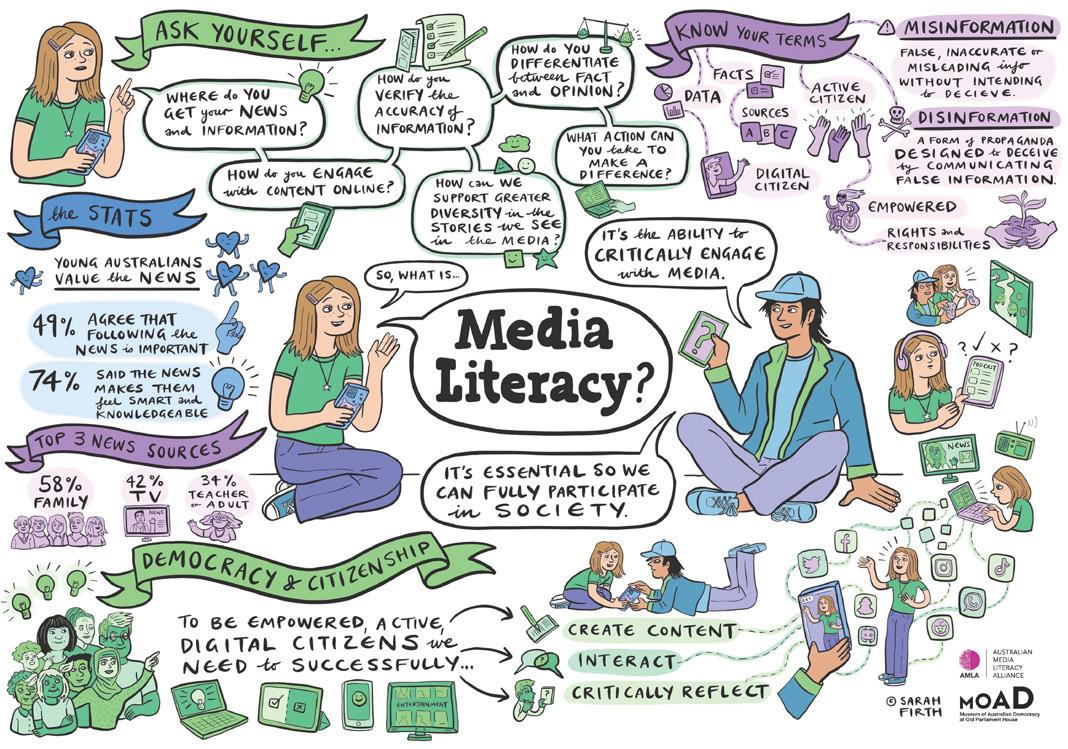
15 Scan Vol 43 Issue 2
Figure 3: Overview of media literacy in Australia, MoAD. (Image: © Sarah Firth. Reproduced with permission.)
alike. However, teaching students how to think critically about all forms of media can provide solid foundations for lifelong media literacy. This is because people with a higher level of critical thinking about media are more likely to ask questions that lead them to identify and avoid misinformation (see Edwards et al., 2021).
Critical thinking is at the heart of news and media literacy
Alongside teaching students about the need to verify and evaluate the source of information and any claims being made, media literacy invites critical thinking about media ‘key concepts’. As leading British media scholar David Buckingham (2019) notes, ‘the media do not offer us a transparent “window on the world”, but a mediated version of it. They don’t just present reality: they represent it’ (p 60). Seen in this way, media provide a lens through which we can analyse and understand ideas and messages about the world while considering how different audiences might receive the same messages differently.
The key concepts approach to teaching media literacy has been used for decades in countries including Australia (Dezuanni, 2015). A media literacy key concepts framework has been embedded in the Australian media arts curriculum since the early 2010s and made more explicit in the latest version of the Media Arts F-10 Curriculum (Australian Curriculum, Assessment and Reporting Authority, 2024).
If students are repeatedly returning to the same critical thinking framework throughout their school years, they are more likely to remember and use this framework as they engage with media throughout their life.
What happens when young people are highly engaged with news?
Our survey shows that young people with the highest level of engagement with news were four times more likely to report they often or sometimes ask critical questions about news stories – like those presented in the key concept framework above – when compared with those with the lowest level of interest in news (76% versus 18%). Young
The following media key concepts and critical questions for students are drawn from the Media Literacy Framework (TRAILR) for Australia (Notley and Dezuanni, 2020):
Technologies
What technology was used to produce, access and circulate this media? Does the technology gather personal data from users? Could the technologies used cause harm or mislead?
Representations
How are people, places or ideas portrayed in this media, and what are the impacts of this?
Audiences
Who was this media made for and how are different audiences likely to respond to it?
Institutions
Who created this media and why did they make it?
Languages
How does this media communicate using image, sounds and written text?
Relationships
What kinds of relationships are being developed (or challenged) through the distribution and use of this media?
people with a high level of engagement with news are also more likely to take actions that will help them to avoid misinformation. For example, they are six times more likely to report checking multiple sources to verify news when compared with young people with a low level of interest in news (63% versus 10%).
16 Scan Vol 43 Issue 2
References
News literacy is particularly important given that AI is now being used to create and circulate highly sophisticated types of disinformation which increasingly pose a threat to the health of our communities.
But not only are young people who are highly engaged with news more likely to be news literate, they are also more likely to take action on issues that matter to them. More than half of those interested in news reported getting involved in social issues (56%) compared to only 9% of those who have the lowest level of interest in news.
Moving forward
A healthy democracy needs well-informed, active citizens who are capable of finding, identifying and creating credible information. For citizens to be well-informed, they need access to lifelong media literacy support.
Media literacy should be essential learning for every Australian student, at all stages of their education, because all students should be supported to develop the skills and knowledge required to thrive in a world which rewards people with higher levels of media ability.
Schools are best placed to provide the right foundations to ensure citizens are asking the critical questions about all forms of media. Media technologies, practices and norms will continually evolve, but a strong critical orientation with media encourages students to routinely pause, think and reflect on what they are consuming and creating.
Acknowledgements: The author would like to thank the survey team collaborators: Professor Michael Dezuanni (QUT), Professor Sora Park and Dr Jee Young Lee (UC), and Dr Simon Chambers and Dr Hua Flora Zhong (WSU). Professor Michael Dezuanni (QUT) collaborated with the author to develop the AMLA media literacy framework included in this article. The survey reported on this article was funded by Meta Australia and the Museum of Australian Democracy (MoAD).
Australian Curriculum, Assessment and Reporting Authority. (2024). Media Arts (Version 9)
Buckingham, D. (2019) The media education manifesto. John Wiley & Sons.
Dezuanni, M. (2015). The building blocks of digital media literacy: socio-material participation and the production of media knowledge (PDF 218 KB).
Edwards, L., Stoilova, M., Anstead, N., Fry, A., El-Halaby, G. & Smith, M. (2021). Rapid evidence assessment on online misinformation and media literacy: final report for OFCOM (PDF 1.3 MB)
Notley, T., Chambers, S., Zhong, H. F., Park, S., Lee, J. & Dezuanni, M. (2023). News and young Australians in 2023: how children and teens access, perceive and are affected by news media. Western Sydney University.
Notley, T. & Dezuanni, M. (2020). Media Literacy Framework for Australia
Notley, T., Dezuanni, M., Zhong, H. F. & Chambers, C. (2020). News and young Australians in 2020: how young people access, perceive and are affected by news media (PDF 422 KB). Western Sydney University and Queensland University of Technology.
Notley, T., Dezuanni, M, Zhong, H. F. & Howden, S. (2017). News and Australian children: how young people access, perceive and are affected by the news (PDF 2.8 MB) Crinkling News, Western Sydney University and Queensland University of Technology.
Notley, T., Zhong, H. F., Dezuanni, M. & Gilbert, S. (2022). Comparing children’s and teens’ news engagement practices and affective news experiences. Journal of Youth Studies. https:// doi.org/10.1080/13676261.2022.2053667
How to cite: Notley, T. (2024). Media literacy – the need for equitable opportunities. Scan, 43(2), 13–17.
17 Scan Vol 43 Issue 2
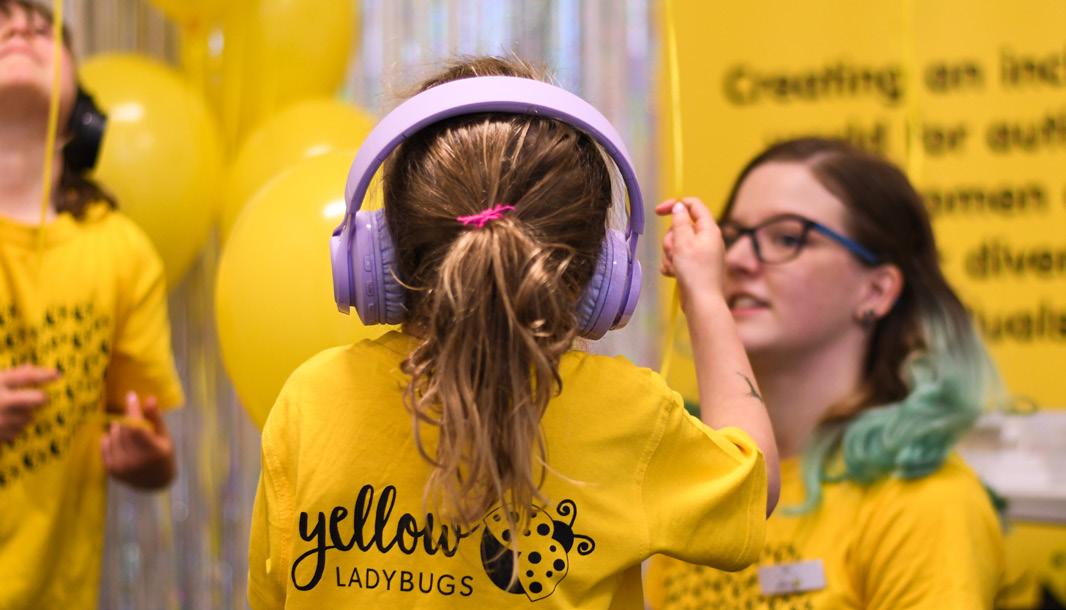
Neuro-affirming approaches to supporting autistic students
 Katie Koullas CEO, Yellow Ladybugs
Katie Koullas CEO, Yellow Ladybugs
Katie Koullas shares her insights into supporting autistic or neurodivergent students in the classroom and beyond.
A note about language
The language we use holds a lot of power. It can shape the way your students see themselves and their place in the world. It can shape the way they see people with different brains, bodies and interests.
This article uses identity-first language – referring to ‘autistic students’ rather than ‘students with autism’. We also avoid using functioning labels (such as ‘high’ and ‘low’ functioning). This reflects our community’s preference – where being autistic is an identity, not a pathology or condition to be fixed or cured. And where we can celebrate and affirm the strengths of different neurotypes, while also recognising the challenges of participating in processes, systems and spaces that weren’t designed with our community in mind.
18 Scan Vol 43 Issue 2
Creating inclusive environments
I remember the day that my daughter wasn’t invited to a birthday party. A student in her class was handing out invitations to all the children and she side-stepped my daughter, continuing to hand out the cards to others in the schoolyard. My heart broke for her as I saw her face drop, her shoulders hunch and her slow, heavy steps traipse back towards the car.
That day, determined to give her a different experience to one of exclusion or confusion, I made a plan to celebrate autistic girls just like her. I didn’t want her to have to mask or contort herself to be able to attend a birthday party that she would most likely find overwhelming – I wanted her to have an experience where the space, the guests, the food and the treats were designed with girls like her in mind.
At that first event, which we ran at the National Gallery of Victoria, I remember seeing families crying as their daughters played side-by-side with other children their age. I remember seeing the expressions on the children’s faces as they looked around and saw other kids with headphones, with messy hair, with special interests that complemented theirs. I remember noticing that with the low lighting and the quiet sounds, with zero expectation as to how they should behave, the children felt safe to explore and connect in their own ways. And I knew I was onto something.
Centring lived experience
Eight years on – and now with my own late autism/ ADHD diagnosis in hand – we’ve continued to grow. In addition to providing events for Yellow Ladybugs (autistic girls) to attend, we’ve evolved into a thriving autistic-led organisation delivering education, training, resources , advocacy and
There are discernible themes that emerge when the voices of autistic students are acknowledged. Equality in rights and access. Safety. Compassion. Curiosity. And choice. These are the principles of neuro-affirming support.
Supporting neurodivergent students doesn’t have to be overly complicated ... [these] insights, once implemented, have the possibility of supporting ALL students to thrive in the classroom.
projects in support of autistic girls, women and gender diverse individuals. We represent this community because – due to bias in the diagnostics and supports as well as our capacity to mask our autistic traits to fit in – autistic girls, women and gender diverse individuals are often misdiagnosed or missed altogether.
Through this experience, I have talked with thousands of autistic individuals about their experience both in and out of the classroom. We have shared this wisdom with hundreds of families, support professionals, carers and teachers – believing that centring the lived experiences of autistic individuals is the key to challenging harmful stereotypes and creating spaces and systems where the wellbeing of autistic students is supported.
Principles of neuro-affirming support
What is overwhelmingly apparent when listening to the stories of autistic individuals is that supporting neurodivergent students doesn’t have to be overly complicated. And that many of their insights, once implemented, have the possibility of supporting ALL students to thrive in the classroom. While each individual has different profiles and therefore needs (in fact, many of us can have high support needs one day and not the next), there are discernible themes that emerge when the voices of autistic students are acknowledged. Equality in rights and access. Safety. Compassion. Curiosity. And choice. These are the principles of neuro-affirming support that we advocate for in the classroom and beyond and which, we believe, should provide the basis for teachers, school leaders and policymakers when considering supports for our community and their families.
19 Scan Vol 43 Issue 2
A while back, we asked some autistic students to share what they wish their teachers knew, some of their responses include:
• ‘I wish my teacher knew that I needed to learn through action.’
• ‘I wish my teacher knew that I took Hall Duty to stay inside away from social situations.’
• ‘I wish my teacher knew that I could already read (well) but I was too shy to read aloud. And that didn’t mean I wasn’t smart.’
• ‘I wish my teacher knew that I had no one to partner with.’
• ‘I wish my teacher knew that me not speaking didn’t mean I had nothing to say.’
• ‘I wish my teacher knew how much energy it takes just to show up.’
• ‘I wish my teacher knew that just because I’m quiet and well behaved, that doesn’t mean I’m OK and not dying on the inside.’
• ‘I wish my teacher knew how desperately I wanted to be chosen for things. My arm ached from stretching my hand up so high.’
• ‘I wish my teachers knew I’m not trying to be difficult, I’m trying to survive in a world built against me.’
• ‘I wish my teacher knew how much I was struggling. That their “quiet dux” was secretly DROWNING.’
• ‘I wish my teacher knew that I was being who I thought she wanted me to be.’
• ‘I wish my teacher knew that because I’m quiet, have an IQ of 138 and read very well, I still struggle to complete assignments after 8 hours in school.’
• ‘I wish my teacher knew that I didn’t get the handbook. I felt, said and did everything in chaos.’
• ‘I wish my teacher knew that it can take me longer to learn new skills – so please be more patient with me.’
• ‘I wish my teacher knew how helpful it was to have visual demonstrations of things. That not all kids learn the same way.’
So how do we practically respond to these stories – in settings where teachers and school leaders may already feel stretched? We’ve found in the past that prescribing specific strategies for schools can be challenging. Each of the settings you operate within will be different and your students will be individual
in their interests, profiles and support needs. This means, for example, that prescribing sensory rooms may not really address the underlying needs for safety and connection of autistic students. Instead, we invite schools and teachers to consider committing to the following principles – the basis of which will allow for individual decisions to be made about classroom and curriculum design, as well as day-to-day management of the classroom.
Unpack bias and ableism
First, we recommend that individually and as a collective, schools commit to the ongoing practice of understanding bias and unpacking ableism. Ableism is conscious or unconscious discrimination, judgement or bias against people with disabilities that positions them as ‘other’ or compares them against a set of norms that might be described as typical or normal. It might feel difficult to acknowledge that, because of the societal norms, we all have ableist ideas or perceptions that impact how we see autistic or neurodivergent individuals, but it is not any one person’s fault. It is a result of the attitudes and behaviours that many of us grow up believing – many of which are modelled by those around us. Continuing to be curious about our perceptions and attitudes of those with different neurotypes allows us to hear the lived experience of our autistic students with more compassion. It allows us to start to challenge stereotypes – for example, that autism looks the same in every individual. Or that autistic people all have the same support needs. That autistic people are all gifted. That girls can’t be autistic. Or that autistic people always also have an intellectual or learning disability. This paves the way not just for a more inclusive classroom, but for a more inclusive society, where we don’t necessarily see disabled people, but individuals who are disabled by systems that weren’t designed with them in mind.
Beginning to look beyond the behaviour and instead focusing on the young person’s need for relational and environmental safety is essential.
20 Scan Vol 43 Issue 2
Understand students’ stress responses and prioritise safety
Second, we recommend that teachers develop an understanding of polyvagal theory and begin to get an understanding of their autistic students’ stress responses. We know that autistic and neurodivergent people spend more time in the fight/ flight/freeze responses. We also know that many of the behaviours that teachers and parents may find challenging are a result of autonomic nervous system responses, trauma or neurodivergent trauma (the trauma resulting from living with a different neurotype in a neurotypical world). Beginning to look beyond the behaviour and instead focusing on the young person’s need for relational and environmental safety is essential. Traditional approaches to rewards or punishment based on a behavioural model are harmful for our community – instead, we encourage working with the young person and their support professionals to understand and reframe challenging behaviour, and create pathways for them to return to safety. Know that in many cases with autistic girls, young women and gender diverse young people, their struggles may not always be externally expressed in big behaviours, but instead directed internally. Eating disorders, anxiety, self-harm, social struggles, overwhelm with schoolwork or ‘school can’t’ (being unable to attend school) may co-occur with autism and/or ADHD and often highmasking students need support as well.
Scaffold learning around special interests and support sensory needs
Last, we encourage teachers to develop relationships with their autistic students. Autistic students and students with ADHD, in particular, can have deep, passionate special interests. When learning is scaffolded around these interests, you may find that you help the individual feel more acknowledged and included (creating safety), and that they learn skills and concepts more easily. It may not be that the student isn’t grasping something or is delayed; it may instead be that you have to work together to find the ways that their brain likes to process information, and what environments are best for that student to learn in. This includes working together to work out what sensory supports need to be put in place. Developing this positive regard for the unique ways that autistic
and neurodivergent brains work – highlighting their strengths while also acknowledging the challenges –can build confidence and esteem, which in turn has a positive effect on learning.
Implementing such strategies and committing to these principles will help ensure that your classroom is neuro-affirming and trauma-informed, not just for your current cohort of students, but for many future students as well.
Editor’s note about language: Throughout this article, we’ve used language which reflects the author’s preferred terminology and use of capitalisation. Some students and their families may prefer identity-first language (such as ‘Autistic student’ or ‘autistic student’), while others may adopt a person-first approach (such as ‘student with autism’). Such language choices are often intentional and meaningful. If unsure, ask the student how they like to refer to themself and use their preferred language.
For further guidance, including advice on using strength-based language, please consult the department’s Language guide
References and further reading
Yellow Ladybugs. (2023). Autistic girls in early childhood [video series]. YouTube.
Yellow Ladybugs & Department of Education Victoria. (2018). Supporting autistic girls at school: spotlight on girls with autism
Yellow Ladybugs & Department of Education Victoria. (2023). Supporting the mental health of autistic girls and gender diverse young people
How to cite: Koullas, K. (2024). Neuroaffirming approaches to supporting autistic students. Scan, 43(2), 18–21.
21 Scan Vol 43 Issue 2
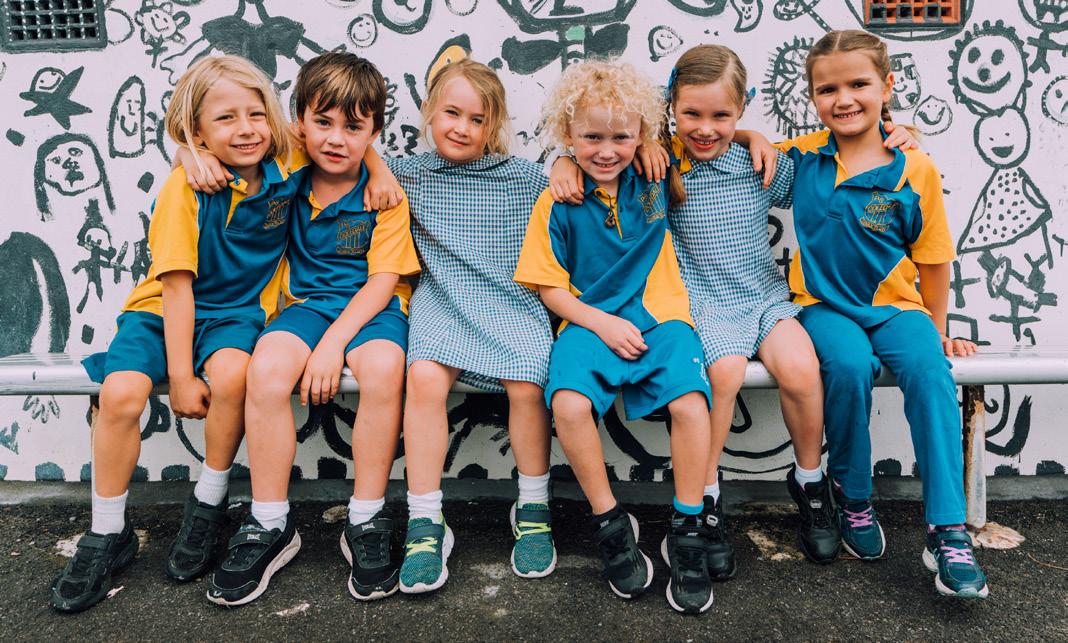
Nurturing allyship among peers of neurodivergent learners – practical tips from I CAN
 Chris Varney Founder and CEO, I CAN Network
Chris Varney Founder and CEO, I CAN Network
Chris Varney outlines practical strategies to support neurodivergent students and create inclusive school environments.
Building more inclusive school communities
One of the recent success stories we’ve witnessed with regards to building a neuro-inclusive school culture certainly didn’t start out that way!
It began with an urgent plea for help from a Victorian high school in early 2022.
In back-to-back instances, 2 of their Autistic students had been mocked and humiliated in social media posts made by non-Autistic peers. Especially troubling was the number of students who were silent bystanders.
22 Scan Vol 43 Issue 2
The school took immediate action to mitigate harm from the situation, but 2 larger questions still loomed over them:
• How do you create a school culture where Autistic students are safe to be themselves?
• How do you help neurotypical students become allies to their neurodivergent peers?
The school turned to our team because addressing these types of questions is at the heart of our work.
I CAN Network is Australia’s largest provider of Autistic-led mentoring and consultancy. I started the organisation off the back of my 2013 TEDx talk: ‘Autism – how my unstoppable mother proved the experts wrong ’. Each year, we help more than 3,000 Autistic young people develop self-acceptance, confidence and a positive identity through our school-based and national online mentoring programs. At the same time, we help foster more

Figure 1: Students participate in I CAN Imagination Club, supported by Patrick Elander (who started as a mentee in 2016 and now leads programs across multiple schools). This inter-school program between Seaholme Primary School and Western Autistic School in Greater Melbourne engages a highly diverse range of neurodivergent mentees. (Image: © I CAN Network, 2023. Reproduced with permission.)
inclusive school communities through student talks and professional development that reflect the lived experience and insights of neurodivergent people. Our school mentoring program has been successfully evaluated against the NSW Department of Education’s quality standards and is listed in the Student Wellbeing external programs catalogue.
Every single Autistic mentor on our team –myself included – knows what it feels like to be misunderstood, marginalised or mocked because of our differences. Yet we also know that when you break down those negative stereotypes, present a more respectful view of Autism and add firsthand accounts of being Autistic, it is possible to foster understanding and allyship. So that’s where we started with the high school in crisis.
Jump-starting a cultural shift
To specifically support Autistic students, the school committed to running I CAN-led mentoring groups on campus. When young people are surrounded by peers and mentors who understand them, and messages that validate who they are, their confidence and self-acceptance grows. This, in turn, has a ripple effect on how other people see them.
Simultaneously, we arranged for several of our Autistic young adult mentors to lead student talks across each year group. They were able to connect with the students on their level.
Each student talk consisted of a 30 minute presentation on what Autism really is – not the pathologised view based on deficits and stereotypes, but insightful, nuanced and personal accounts. Afterwards, there was ample discussion time for students to ask questions. There was an obvious shift in the energy of the room as the session unfolded, with students really ‘leaning in’ to the discussion. This opened the door for further conversations about Autism and neurodiversity –the difference is, now Autistic students from that school are helping to drive the dialogues!
A school that once reached out to us in desperation is now a compelling example of how understanding and allyship can flourish.
23 Scan Vol 43 Issue 2
Advice for teachers
Here are some additional tips from our Autistic mentors and mentees on fostering allyship among neurotypical students. Although these insights are primarily around Autism, they can be applied to various forms of neurodivergence, including ADHD, dyslexia and more.
Tip 1: Talk often and openly about neurodiversity
It’s never too soon to introduce students to respectful representations of Autism and neurodiversity, including the positives of having a neurodivergent brain.
As one of our student mentees describes:
One of the biggest reasons to talk about Autism positively is so that Autistic children can grow up feeling good about themselves, and their peers understand that being Autistic is all right.
The more people who hear positive things about Autism when they are young, the better chance we have of building a world that is inclusive.
A great starting place is introducing students to the concept that diversity is a beautiful and valuable part of our world. In working with very young learners, we often take a multi-step approach:
1. identify things that are different (animals, toys, and so on)
2. identify the many ways that people are different
3. identify the ways our brains are different
4. discuss the strengths of our own brains
5. recognise the things that are hard for our own brains and what type of support helps.
A key message we convey is that all brains are valuable - none is superior or inferior to another.
Our list of respectful resources for talking to young people about Autism and neurodiversity includes a number of inclusive books about neurodiversity and free resources by neurodivergent content creators.
For example, one of our favourite books for introducing the concept of neurodiversity to young students is The Brain Forest by psychologist Sandhya Menon, who is neurodivergent herself. For older students, ‘A story about brains and phones’ by
More Than One Neurotype, provides a very effective analogy for explaining neurodiversity and the importance of acceptance.

Tip 2: Recognise the importance of representation and lived experience Chloé Hayden , the first openly Autistic Australian to co-lead a TV series (the award-winning Heartbreak High) often talks about the importance of representation. Historically, we neurodivergent people have been overlooked or portrayed negatively.
It is vital that neurodivergent young people see respectful representations of neurodivergence; it is important that their neurotypical peers are exposed to the same.
This exposure can come in many forms: books featuring neurodivergent lead characters , videos , websites and blogs by neurodivergent young people, social media accounts and more. Older students might enjoy learning more about openly neurodivergent people who have made distinctive contributions or found fulfillment not in spite of being neurodivergent, but because they have leveraged their unique perspectives and capabilities.
The one key caveat is to ensure that students don’t internalise a belief that neurodivergent people only have value if they are famous or ‘top achievers’.
One of the most powerful ways to foster allyship is to ensure that neurotypical students have a chance to listen to and learn from neurodivergent people
24 Scan Vol 43 Issue 2
Figure 2: The Brain Forest by Sandhya Menon (Onwards and Upwards Psychology, 2022)
in real time, especially from neurodivergent young adults who have formed a positive self-identity despite societal barriers and misconceptions. We believe this is why our student talks deliver such impact. Schools can replicate this approach by inviting neurodivergent recent graduates, community members or young neurodivergent advocates who are active in this arena.
Tip 3: Provide explicit direction on how to include and support neurodivergent
peers
So often, when a neurodivergent young person is struggling socially, the onus is placed on them to develop social skills that will allow them to ‘fit in’ with their neurotypical peers or develop ‘more resilience’ to deal with rejection.
As one of our young mentees notes: People are always telling me the things I need to do to fit in with other kids, but no one tells the other kids the things they can do to make me feel like I belong.
Genuine inclusion requires everyone to make an effort. Even the most kind-hearted neurotypical students might need some explicit direction on how to be an ally. Advice such as ‘be kind’ is not concrete enough.
Younger students
For primary students, neuro-inclusive social stories on topics such as Social Skills for Everyone (PDF 189 KB) by Erin Casey are immensely valuable because they help explain the different ways people engage with the world and provide specific examples of actions students can take to be more inclusive.

Implement neuro-friendly classroom practices, such as movement breaks, not insisting on eye contact, providing extra time for responses, and giving students flexibility in how they share projects ...
Older students
For older students, neurodivergent young people can offer outstanding insights on what actions constitute allyship. Case in point, these two recommendations on ‘How to be an ally’ were written by young Autistic high school students:
• ‘See someone stimming? That’s actually a good thing. Let them stim. Don’t mock them or laugh at them behind their backs.’
• ‘If you see a friend or peer struggling, ask them if you can help. Keep the requests very simple: “Do you need me to get a teacher?’”; “Do you need some water?” Help them get some space. Again, don’t mock them or laugh behind their backs.’
Tip 4: Model respectful allyship yourself
Adults of influence, such as teachers and school leaders, can play such a pivotal role in modelling respectful allyship.
Here are some actions that can make a big difference:
• Validate and support LGBTQIA+ students. There is an overlap between the LGBTQIA+ and neurodivergent communities , so when you promote allyship toward the former, you are also creating a more welcoming environment for the latter.
• Implement neuro-friendly classroom practices, such as movement breaks, not insisting on eye contact, providing extra time for responses, and giving students flexibility in how they share projects (for example, presenting to the class, presenting one-on-one to the teacher, making a video).
25 Scan Vol 43 Issue 2
Figure 3: Social Skills for Everyone: making friends and getting along (PDF 189 KB) by Erin Casey (2017)
• Continue to grow your own knowledge base about neurodivergence by learning from lived experience resources . For example, Reframing Autism offers an on-demand introductory workshop on teaching Autistic students . Run by Dr Melanie Heyworth, the online session includes lived-experience insights into Autistic needs and practical strategies for supporting Autistic learners.
• Normalise accommodations by talking about the support you need to get certain things accomplished or stay regulated (for example, setting reminders on your phone, making lists, deep breathing when you are stressed). Through modelling, scaffolding and explicit instruction, help students develop relevant metacognitive strategies in their own learning.
• Avoid the ‘buts’ that reinforce negative stereotypes. (For example, ‘He’s Autistic but he’s very caring’, ‘They have ADHD but they’re very well behaved’, ‘She’s dyslexic but she’s very clever’.)
• Embrace your passions and quirks, no matter what they are. Are you a Trekkie? A huge fan of Taylor Swift? Love cats? Do you have any habits that you need in order to function? Certain sensory needs? When adults embrace their passions and embrace their differences (big and small), it signals to all students that it’s okay to do the same.
It’s exciting to live in a time when young people can learn about concepts like neurodiversity and allyship from a young age. In the words of one of our young mentees, ‘a world that embraces neurodiversity is friendly, accepting, innovative, and in short, it’s the coolest world.’ Indeed, it is. Together, we can help create environments where neurodivergent students and their allies can thrive.
Editor’s note about language: Throughout this article, we’ve used language which reflects the author’s preferred terminology and use of capitalisation. Some students and their families may prefer identity-first language (such as ‘Autistic student’ or ‘autistic student’), while others may adopt a personfirst approach (such as ‘student with autism’).
Suggested resources
I CAN Network
Our website contains information about our Autistic-led school-based, online and professional development programs, plus insights and resources created by Autistic young people. In addition, it offers links to our social media accounts that regularly feature a diverse array of neurodivergent voices.
Neurodiversity Celebration Week
Founded by multiply neuodivergent high school student Siena Castellon in 2018, Neurodiversity Celebration Week is now celebrated by more than one million participants around the world each year. Slated for March 2025 (specific dates to be announced) it offers an opportunity to discuss and celebrate the array of neurodiversity represented in our school communities.
Learning About Neurodiversity at School (LEANS)
The LEANS resource pack is a free, neuro-affirming curriculum for students aged 8–11. It was developed by a neurodiverse team of researchers and educators, led by researchers from the University of Edinburgh.
Such language choices are often intentional and meaningful. If unsure, ask the student how they like to refer to themself and use their preferred language.
For further guidance, including advice on using strength-based language, please consult the department’s Language guide
26 Scan Vol 43 Issue 2
References and further reading
Alcorn, A. M., Fletcher-Watson, S., McGeown, S., Murray, F., Aitken, D., Peacock, L. J. J. & Mandy, W. (2022). Learning about neurodiversity at school: a resource pack for primary school teachers and pupils . University of Edinburgh.
Ashburn, M. (2021, August 25). 100-ish inclusive children’s books on Autism and neurodiversity Not an Autism Mom.
Bonnello, C. (2023). Underdogs
Casey, E. (2017). Social skills for everyone: making friends and getting along (PDF 189 KB)
Chloé Hayden. (2023).
Communication First. (2021, April 15). ‘Learn from us’ movie [Video]. YouTube.
Cook, M. (2023, 12 November). Creating an inclusive classroom: insights from the Autistic teacher The Autistic Teacher
I CAN Network. (2023). Autistic-led services for young people and organisations.
I CAN Network. (2023). Autistic LGBTIQA+
I CAN Network. (2023). Respectful resources for talking to young people about Autism and neurodiversity
Katy, E. (2023). Authentically Emily
Menon, S. (2022). The brain forest. Onwards and Upwards Psychology.
More Than One Neurotype. (2021, March 22). A story about brains and phones. Facebook. Retrieved April 26, 2024.
Neurodiversity Celebration Week. (2023).
NSW Department of Education. (2023). Student Wellbeing external programs catalogue
Reframing Autism. (2023). Professional development: an introduction to teaching Autistic children
Spectrum Gaming. (2023). Autism Understood: a website about Autism, for Autistic young people.
Varney, C. (2013, June 17). Autism - how my unstoppable mother proved the experts wrong [Video]. TEDxMelbourne.
How to cite: Varney, C. (2024.) Nurturing allyship among peers of neurodivergent learners –practical tips from I CAN. Scan, 43(2), 22–27. Foster a love of reading in the classroom with The School Magazine
• a wide variety of high-quality text types for ages 7 to 12+
• syllabus-aligned learning resources and audio recordings
• affordable print and digital subscription options
Learn more at theschoolmagazine.com.au
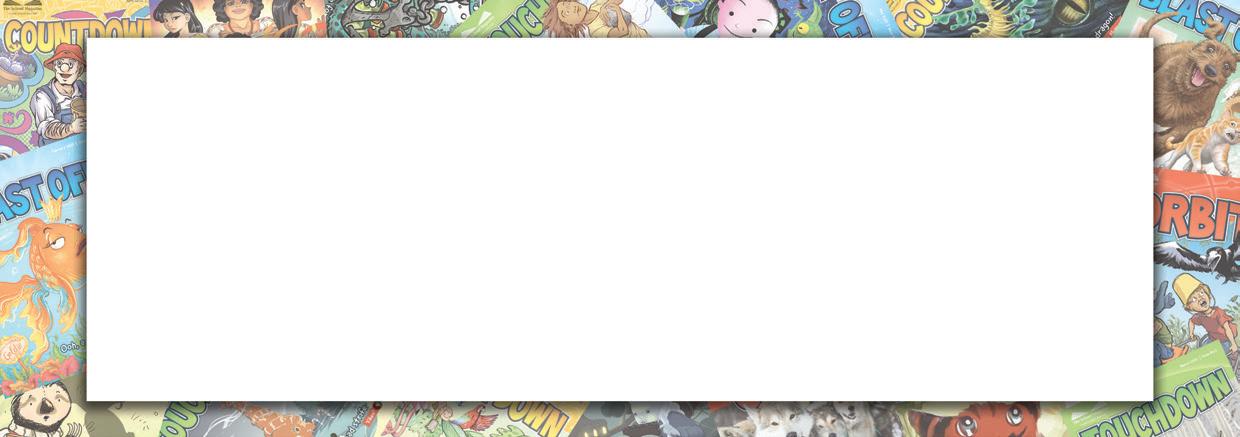
27 Scan Vol 43 Issue 2
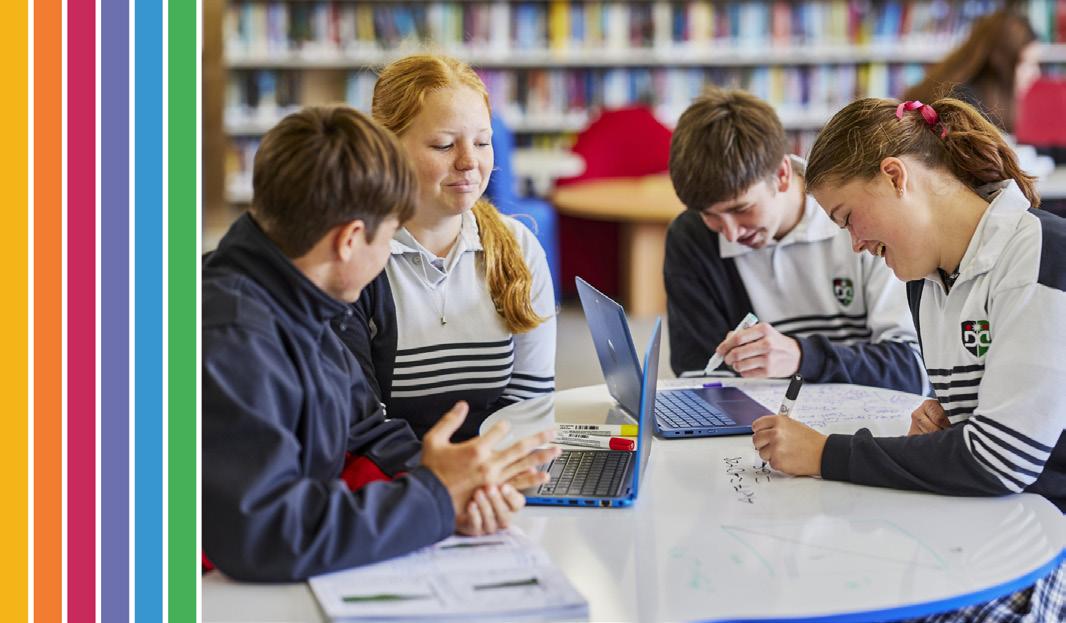
Celebrating neurodiversity at Smith’s Hill High School


Daniel Jones
Teacher Librarian, Smith’s Hill High School
Brodie Jones
Visual arts teacher, formerly Smith’s Hill High School
Daniel Jones and Brodie Jones explain how Neurodiversity Celebration Week activities at Smith’s Hill High School create opportunities to increase wellbeing within the school community.
How often do you reach out and tell every student that their mind, their experience, their ideas, their differences, their striving to overcome challenges, and their character, are all wholly valuable?
Held annually in March, Neurodiversity Celebration Week presents opportunities to do all these things. By valuing diversity, developing understanding of self and others, and considering new ways to act and think more inclusively, Neurodiversity Celebration Week creates opportunities to increase wellbeing for students, staff and your community.
28 Scan Vol 43 Issue 2
Understanding neurodiversity
Neurodiversity, often represented by the rainbow infinity symbol (Figure 1), refers to the infinite diversity of all human minds and all the variations in neurocognitive functioning that occur in our species (Walker, 2023). As Walker notes, the neurodiversity paradigm values diversity of neurotypes as a source of valuable potential and rejects the notion that only one type of brain is ‘right’ or ‘normal’. Neurodiversity is often used in the context of autism, attention deficit hyperactivity disorder/ condition (ADHD/ADHC), dyslexia, dyscalculia and dyspraxia (American Psychological Association, 2023; Neurodiversity Celebration Week, 2023). As such, Neurodiversity Celebration Week recognises the full range of ways people think, move, process information or communicate.
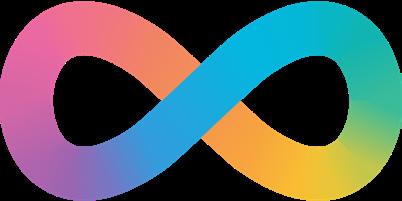
Sydney sociologist Judy Singer coined the term ‘neurodiversity’ in 1998 by combining ‘neuro’ and ‘diversity’ to link to more valued forms of diversity like cultural diversity and biodiversity (Silberman, 2013). Initially used within the autistic rights movement, Singer’s term is increasingly used by other neurodivergent communities, forming the neurodiversity movement (Walker, 2023). As a social justice and civic rights initiative, the neurodiversity movement combats discrimination and marginalisation of neuro-minorities; it
Neurodiversity Celebration Week: March 2025
About
Founded by student Siena Castellon in 2018 (then age 16), Neurodiversity Celebration Week seeks to ‘recognise the many talents and advantages of being neurodivergent, while creating more inclusive and equitable cultures that celebrate differences and empower every individual’ (Neurodiversity Celebration Week, 2023; United Nations, n.d.).
Castellon – who is autistic, dyslexic, dyspraxic and has ADHD – sought to change the focus on challenges produced by neurological diversity, to a ‘balanced view which focuses equally on our talents and strengths’ (Neurodiversity Celebration Week, 2023).
This worldwide initiative challenges stereotypes and misconceptions about neurological differences and is celebrated by thousands of schools , universities and organisations, including the UN Youth Envoy.
Get involved
• Access a range of resources including:
• suggested activities
• printable posters celebrating neurodivergent celebrities and high achievers
• videos about neurodiversity (see, for example, Figure 2)
• social media templates , including banners, cards and virtual backgrounds.
• Select neuro-affirming resources for your school library. (For example, reading aloud The Brain Forest by Sandhya Menon could provide one entry point into learning activities for younger students. For broad guidance regarding text selection and auditing existing school resources, see Rebecca Toltz’ 2022 Scan article on Diversity, inclusion and representation: resourcing the curriculum .)
• Collaborate with your P&C diversity and inclusion subcommittee, if available.
• See how others have celebrated Neurodiversity Celebration Week, such as Marrickville Public School
• Register to take part in 2025 events.
29 Scan Vol 43 Issue 2
Figure 1: Rainbow infinity symbol. (Image: Neurodiversity symbol by Mrmw. Licenced under CC0 1.0 DEED.)
is also informed by the social model of disability and positive psychology in its strengths-based perspective that sees disability as often a product of design ignoring the needs of minority groups (Leadbitter et al., 2021).
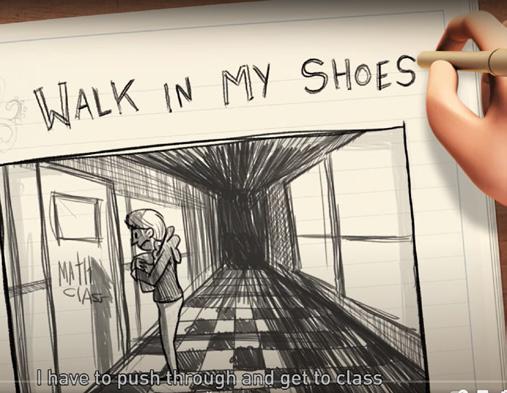
Acknowledging neurodiversity at Smith’s Hill High School
A common misconception of academically selective high schools is that they are populated by high-achieving and gifted students who excel in mainstream education. The very naming of a subset of learners as high potential or gifted (HPG) can lead to problematic preconceptions; similarly, other neurotype names containing deficit and disorder may be problematic. Our school is an academically selective school and has a neurodiverse population of learners, including students who are high potential or gifted, autistic, dyslexic, have ADHD, or are high potential or gifted with disability, and more (Wyatt, 2023).
Our Principal, David Dietz, openly acknowledges being on the autism spectrum; an action that role models self-valuing and significantly contributes to developing a safe and inclusive environment. Our Learning Hub team is welcoming, inclusive and adept at equipping a wide range of students with learning strategies and facilitating self-belief. We have a range of wellbeing, mentoring and leadership programs, and it is fair to say that we have significant supportive frameworks for our students.
Neurodiversity Celebration Week: an opportunity
We began seeing the need for something like Neurodiversity Celebration Week when working as part of the High potential and gifted education (HPGE) policy implementation team. Some goals of implementation were contingent upon social and emotional dispositions, mindsets, and even cultural values. For example, creative and critical thinking requires opportunities to cultivate an openness to new experiences and risk-taking with learning; however, we know a predisposition to perfectionism, or maladaptive perfectionism , can be a barrier to developing those skills for some students (NSW Department of Education, 2023a).
Likewise, social norms around avoiding disclosing neurological differences, or just fearing being ‘different’, increases risks for underachievement and disengagement. Coupled with this, high potential and gifted students in an academically selective high school may exhibit ‘forced-choice dilemma’. This refers to a choice some HPG students may face that may:
• include a need for peer acceptance and a desire for high achievement
• result in students comparing themselves to their peers
• worsen in the teenage years when ‘fitting in’ can become more important than achieving
• lead to HPG students masking their abilities.
In Neurodiversity Celebration Week, we saw the opportunity to shift perceptions of neurodivergent people to more of a strengths-based view and to cultivate a culture which values ‘difference’. Opportunities to speak about strategies to identify and grow strengths, and reduce challenges are also present. As the High potential and gifted education evaluation and planning tool (PDF 2.9 MB) (2020) points out, ‘a supportive learning environment that celebrates excellence, individuality and personal growth helps sustain student engagement and foster wellbeing across all the domains’ (p 56).
A slight name change
In 2022, when we first held Neurodiversity Celebration Week at Smith’s Hill High School, we chose to call it Neurodiversity Week. At that time, we cautiously omitted ‘celebration’, in case
30 Scan Vol 43 Issue 2
Figure 2: ‘ Walk in my shoes’ by Donaldson Trust (10:22 minutes, YouTube)
the term was perceived as insensitive to students whose current experience of neurodivergence was overwhelming. Launching Neurodiversity Week in 2022, we started small.
Activities included:
• a launch at whole school assembly
• posters (downloaded from the Neurodiversity Celebration Week website) displayed in several locations
• a display in the library (see Figure 3), including fiction and non-fiction texts and printed resources for students, such as a find your strengths checklist
• shared information via email and school social media. Themes included, ‘What is neurodiversity and Neurodiversity Week?’ and ‘Gratitude for the strengths of neurodiversity’.
Community feedback
In 2022, a Year 11 student warmly thanked us for what they described as the first time it felt like giftedness and neurodiversity were openly talked about at school. Encouraged by this, in 2023, we grew Neurodiversity Week. Additional communication topics included ‘Neurodiversity strengths’, ‘Podcasts about neurodiversity’, ‘Coaching for executive functioning challenges’, ‘Self-advocacy’, and ‘The Hero’s Journey of Neurodivergence Self-Acceptance’. (For example, Figure 4 is an image used as a prompt to encourage discussion of students’ feelings about neurodivergence.) Information was also emailed to students and staff, and excerpts were posted to the school’s social media page, which linked to an expanded version on the school library website.
Student feedback on Neurodiversity Week revealed valuable gains. Comments included:
• ‘it helped me think about different ways I can study’
• ‘I have a lot more respect toward other people’s needs and abilities’
• ‘I realised that it’s okay to learn in different ways’
• ‘I’ve noticed people talk about being neurodivergent more now; before, being on the spectrum was something you only told your closest friend’.
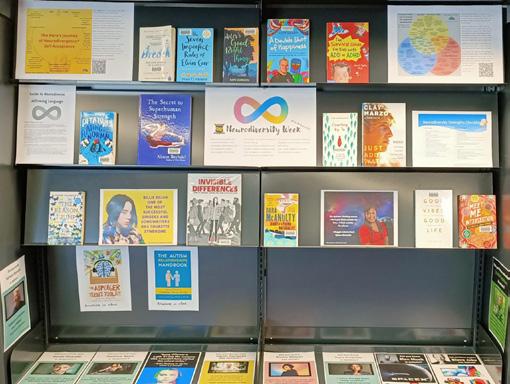
When we support neurodivergent students, we support their families as well. A sample of parent feedback after the week indicated the value of the event beyond the school walls: Just wanted to say thank you for the social media posts and emails to students last week about neurodiversity. The recommendations were excellent and I’ve started listening to the Neurodiversity Podcast … messaging like yours is really important if we are going to shift attitudes and perceptions, so thank you again.
Next steps
Late in 2023, we began planning for 2024. We surveyed students on their experience of Neurodiversity Week and what they wanted from future iterations.
Thirty-seven percent of respondents felt more empowered to contribute to an inclusive community as a result of Neurodiversity Celebration Week, and 38% of respondents wanted more activities they could get involved in. We used this ‘student voice’ to plan our 2024 lunchtime activities, including daily workshops focused on:
• identifying strengths (and strategies to build them)
• exploring opportunities for using artificial intelligence as a planning tool for assessment tasks (executive functioning skills for students)
• bullet journalling as a diary alternative and reflective journals for habit tracking
• strategies for self-regulation and wellbeing
• finding your tribe: open day for student led clubs.
31 Scan Vol 43 Issue 2
Figure 3: Neurodiversity Week display in the Smith’s Hill school library
While only 20% of respondents felt encouraged to talk about neurodiversity as a result of the week, we are going to workshop with students a conversation prompt such as, ‘R U OK?’ or something along the lines of, ‘What’s learning feel like for you?’. We are also considering collaborating with students and the community to create a set of posters promoting the achievements and characteristics of Australian neurodivergent people across one or more domains of potential. Students also called for a more balanced representation of neurodiversity, including the challenges experienced.
Spreading the word
At Smith’s Hill High School, we have responded to demand, progressing from a low initial level of commitment to neurodiversity by, amongst other things, incorporating more student voice and encouraging broader school involvement and opportunities for engagement. We wholeheartedly encourage you to consider if Neurodiversity Celebration Week is potentially something your school could benefit from. If so, start with some conversations to learn more from neurodiversityaffirming perspectives. Be prepared to bring others on the journey; we have found that by clearly

32 Scan Vol 43 Issue 2
Figure 4: The Hero’s Journey of Neurodivergence Self-Acceptance. (Katy Higgens-Lee, 2022. Reproduced with permission.)
explaining our reasons, the nature of the neurodiversity paradigm, and its implications for student wellbeing, our allies and advocates amongst staff and students have increased in number.
As teachers, we consistently seek to ensure that ‘every student is known, valued and cared for’ (NSW Department of Education, 2023b). Where neurodivergent students are also high potential or gifted, we have additional responsibilities within the High potential and gifted education policy (2022), including:
• 1.3.2 High potential and gifted students with disability should be provided with support, including reasonable adjustments for disability, to allow them to participate in their education on the same basis as high potential and gifted students without disability
• 1.5 Learning environments which support the social-emotional development and wellbeing of high potential and gifted students enables them to connect, succeed and thrive.
• 1.5.1 Schools have a responsibility to create learning environments that support high potential and gifted students to experience efficacy, agency and achieve their educational potential.
• 1.5.2 Schools should work collaboratively with students, parents/carers and the community to support wellbeing, growth and achievement.
If you’re ready to let every student know that their mind, their experience, their ideas, their struggles and their character are valuable, and if you are ready to find new ways of making our world genuinely more inclusive, you are ready to host Neurodiversity Celebration Week at your school. To assist, the Smith’s Hill High School Library webpage ‘Celebrating Neurodiversity ’ contains sample texts for communication, links to resources and further support materials. Also, teachers and school leaders might view Tilly’s Story (NSW Department of Education, 2024), an illustration of practice that highlights the collaboration between various stakeholders that was necessary to nurture Tilly’s creative high potential and cater for her needs as a student with multiple disabilities. This resource includes a set of professional learning
In Neurodiversity Celebration Week, we saw the opportunity to shift perceptions of neurodivergent people to more of a strengthsbased view and to cultivate a culture which values ‘difference’.
questions, which could be modified to probe specific considerations around supporting neurodivergent students.
Editor’s note about language: Throughout this article, we’ve used language which reflects the authors’ preferred terminology and use of capitalisation. Some students and their families may prefer identity-first language (such as ‘Autistic student’ or ‘autistic student’), while others may adopt a person-first approach (such as ‘student with autism’ or ‘student on the autism spectrum’). Such language choices are often intentional and meaningful. If unsure, ask the student how they like to refer to themself and use their preferred language.
For further guidance, including advice on using strength-based language, please consult the department’s Language guide
References and further reading
American Psychological Association. (2023). Inclusive language guide
Leadbitter, K., Buckle, K. L., Ellis, C. & Dekker, M. (2021). Autistic selfadvocacy and the neurodiversity movement: implications for autism early intervention research and practice. Frontiers in Psychology, 12 https://doi. org/10.3389/fpsyg.2021.635690
Neurodiversity Celebration Week. (2023). Celebrating different minds
33 Scan Vol 43 Issue 2
NSW Department of Education. (2020). High potential and gifted education policy: evaluation & planning tool (PDF 2.9 MB)
NSW Department of Education. (2022). High potential and gifted education policy.
NSW Department of Education. (2023a). High potential and gifted education: implement
NSW Department of Education. (2023b). Our Plan for NSW Public Education.
NSW Department of Education. (2024). Domains of potential (Tilly) – film
Smith’s Hill High School Library. (2020). Celebrating neurodiversity
Solomon, A. (2008, May 2). The Autism Rights Movement The New York Magazine
Toltz, R. (2022). Diversity, inclusion and representation: resourcing the curriculum Scan 42(6), 30–34.
United Nations. (n.d.). Siena Castellon.
Walker, N. (2023). Neurodiversity: some basic terms & definitions
Wyatt, J. (2023). Understanding and supporting gifted students with disability. Scan, 42(1). 46–52.
How to cite: Jones, D. & Jones, B. (2024). Celebrating neurodiversity at Smith’s Hill High School. Scan, 43(2), 28–34.
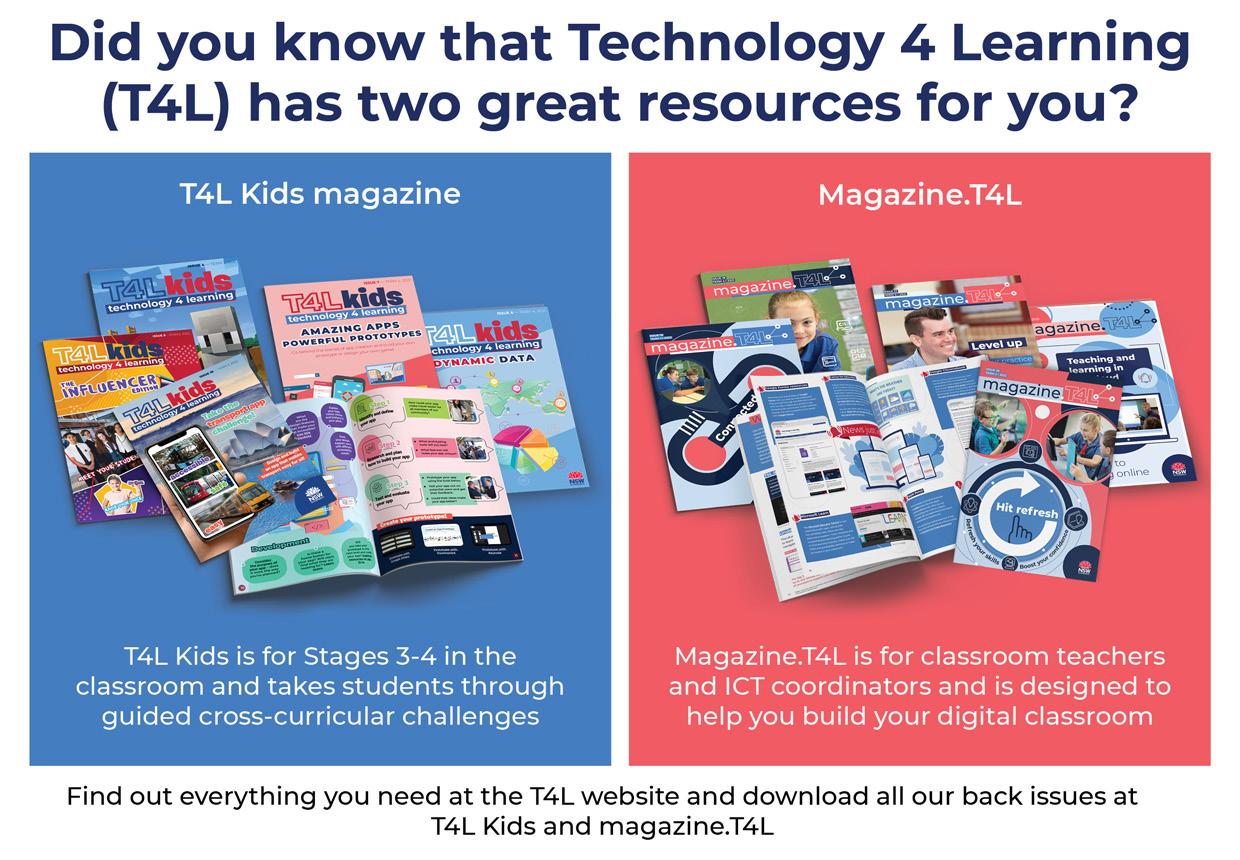
34 Scan Vol 43 Issue 2

Term 2 Premier’s Reading Challenge booklist update – graphic novels and illustrated chapter books

Jade Arnold
Premier’s Program Officer, Reading and Spelling
Jade Arnold introduces new additions to the Premier’s Reading Challenge (PRC) booklist and describes how graphic novels and illustrated chapter books support reading success and engagement.
Valuing graphic novels and illustrated chapter books
Graphic novels and illustrated chapter books are excellent tools for engaging students and allowing them to experience both success and enjoyment in their reading.
Narratives presented in graphic novel format utilise illustrations to perform the heavy lifting when it comes to world-building and characterisation. This is beneficial for readers who lack confidence or reading stamina, as they often find these two key pillars of storytelling overwhelming or tedious. Reluctant readers who might find ordinary chapter
35 Scan Vol 43 Issue 2
books difficult to decode independently can draw from contextual clues in illustrations. Despite their apparent simplicity, graphic novels are rich multimodal texts that require students to decode meaning using the linguistic, visual, gestural and spatial semiotic systems, meaning that graphic novels will also appeal to more advanced readers.
While illustrated chapter novels don’t require the same level of semiotic decoding as graphic novels, they play a critical role in early primary library collections as they provide an important transition from picture books to chapter books that allows newly independent readers the opportunity to develop reading stamina.
New inclusions on the PRC booklist
The following graphic novels and illustrated chapter books feature in the Premier’s Reading Challenge Term 2 2024 booklist update.
The Faint of Heart
Author: Kerilynn Wilson
ISBN: 9780063116221
Released: September 2023
Publisher: HarperCollins US
Booklist: 7-9
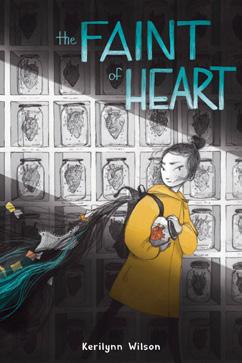
A beautiful, evocative and layered tale about the importance of experiencing the wide gamut of human feelings, this graphic novel is bound to stay with readers long after they read the final page.
The Faint of Heart is set in an alternate future where a mysterious figure, known simply as ‘The Scientist’, has discovered a groundbreaking treatment guaranteed to eliminate all forms of pain. A patient’s heart is removed and placed in a jar full of numbing solution, removing all sadness, anxiety and anger – along with all the good feelings too. Despite this known side-effect, the
procedure’s popularity spreads until our protagonist, June, is the only person left with a heart. Her ability to feel, create and care makes her a social outcast among her family and friends, and pressure mounts for June to undergo the procedure too.
The written text is accompanied by engaging illustrations that are predominately monotone; the occasional deliberate use of colour builds meaning throughout this tender and captivating narrative. While Wilson’s language isn’t overly complex, the story’s central concepts, including exploration of morality and the purpose of emotions, require a slightly more sophisticated reader that is able to unpack subtext.
The Faint of Heart is a perfect read for students looking for a graphic novel that dives a little deeper than the typical school/friendship dramas and superhero narratives the format is well-known for.
Four Eyes
Author: Rex Ogle
Illustrator: Dave Vazeza
ISBN: 9781338574968
Released: May 2023
Publisher: Scholastic
Booklist: 5-6
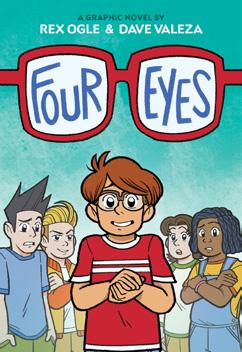
Four Eyes is an engaging, funny and inspirational story that a wide range of students will relate to and thoroughly enjoy. This semiautobiographical coming-of-age tale follows Rex as he starts his first year of middle school.
While Rex is initially excited for the start of the school year, it ends up being far tougher than anticipated. Rex’s best friend abandons him for more popular students and his lack of a growth spurt makes him an easy target for bullies. When Rex develops vision problems and his family can only afford the cheapest (and
36 Scan Vol 43 Issue 2
Figure 1: The Faint of Heart by Kerilynn Wilson (2023, HarperCollins US)
Figure 2: Four Eyes by Rex Ogle and Dave Vazeza (2023, Scholastic)
ugliest) frames, Rex’s new glasses also become a focus of bullying, along with his family’s financial issues. These challenges are exacerbated by Rex’s strained relationship with his father (who has divorced his mother and started a new family). Rex’s father treats him like a financial burden and the conflict that evolves between Rex, his mother and his father is upsetting to read.
Despite this, one of the most heartwarming and well-executed elements of this story is Rex’s relationship with his family, particularly as the adults in Rex’s life are portrayed as flawed, threedimensional characters. Rex’s mother is presented as imperfect but caring, owning up to her mistakes as a mother and taking steps to rectify them. Rex’s stepfather is empathetic and heavily involved in Rex’s life, advocating for him when needed. Rex’s grandmother provides sage advice about accepting who he is and dealing with bullies.
With its bright, crisp illustrations, strong character development and relatable conflicts, Four Eyes will have wide appeal among middle to upper primary and lower secondary readers.
Frog Squad: dessert disaster
Author: Kate Temple and Jol Temple
Illustrator: Shiloh Gordon
ISBN: 9781460764428
Released: April 2024
Publisher: HarperCollins
Booklist: 3-4 easy reads
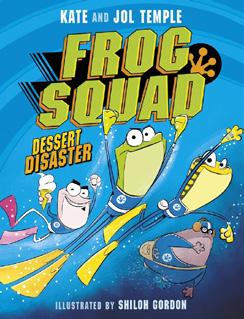
The newest offering from Kate and Jol Temple is a hilarious chapter book with graphic novel-style illustrations, which serves as a great introduction to the graphic novel format.
Frog Squad contains the same wit and humour featured in the Bin Chicken series, with puns, wordplays
and primary school-style jokes featuring heavily throughout the novel. The story itself is a simple, fast-paced adventure with amusing stakes: a mega tanker responsible for all ice-cream production has been stolen by The Organisation of Amphibious Devious Scoundrels (TOADS), and without the Frog Squad’s intervention, TOADS will control the global supply of ice cream!
Despite the prolific jokes, Frog Squad manages to weave environmental knowledge into the narrative. Each character is a different species of frog and readers are introduced to facts unique to each species that will become fun conversation points for readers, while also supporting understanding of sustainability and conservation.
These facts don’t detract from the sheer entertainment value of Frog Squad – it’s sure to delight newly independent readers and older, less confident readers in middle primary alike.
Bluey: trains
Author: Bluey
Illustrator: Rafferty Amor
ISBN: 9781761041105
Released: March 2024
Publisher: Puffin Australia
Booklist: K-2

The award-winning TV show Bluey already has several picture books, but this is the first in a new series of illustrated chapter books that capture the popularity and humour of Bluey.
Bluey: trains follows the narrative of the TV episode of the same name: The Heelers play a game of make-believe where Dr Glenda must catch the train to drop off her child at daycare before going to work as a vet, but their journey is derailed by an annoying passenger.
37 Scan Vol 43 Issue 2
Figure 3: Frog Squad: dessert disaster by Kate Temple, Jol Temple and Shiloh Gordon (2024, HarperCollins)
Figure 4: Bluey: trains by Bluey and Rafferty Amor (2024, Puffin Australia)
The novel itself doesn’t feature Bluey and her family - rather, the narrative takes us inside the imagination of Bluey and Bingo. We follow the characters the Heeler family have invented, including Dr Glenda, Granny Marge and the train driver, and this concept is explained by a cast list at the beginning of the story, along with illustrations that clearly identify Bingo and her family.
The story itself is fast-paced, funny and chaotic in a way that will be familiar to Bluey fans. At just 80 pages, this is a great chapter book that will appeal to newly independent readers in Years 1 and 2 who are making the leap from picture books to chapter books.
Other graphic novels in the Term 2 booklist update
Buzzing
Author: Samuel Sattin
Illustrator: Rye Hickman
ISBN: 9780316628419
Released: November 2023
Publisher: Hachette Children’s Books
Booklist: 7-9

Offering an important insight into the mind of a 12-year-old boy with Obsessive Compulsive Disorder (OCD), who finds solace and friendship through a tabletop roleplay game similar to Dungeons and Dragons, this engaging text will appeal to many teen readers. The narrative helps destigmatise OCD through its representation of accepting and supportive friends. A must-have for secondary library collections.
Break (Click series)
Author: Kayla Miller
ISBN: 9781760655198
Released: March 2024
Publisher: Walker Books Australia
Booklist: 5-6

This continuation of the popular Click graphic novel series also works as a standalone. Olive receives her first smartphone during summer break, which she’s forced to spend with her father (who has just come back into her life), rather than with her friends. Olive spends her time obsessing over her friends’ holidays, which she follows over social media, rather than enjoying her own break and reconnecting with her father – until she receives sage advice from a frenemy. This will be popular in upper primary and lower secondary collections.
Officer Clawsome: lobster cop
Author: Brian Smith
Illustrator: Chris Giarrusso
ISBN: 9780008606909
Released: January 2024
Publisher: HarperCollins
Booklist: 3-4 easy reads
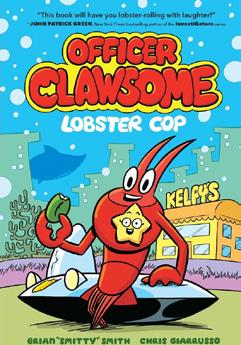
This fast-paced and thoroughly entertaining new series features a lobster and starfish crime-fighting duo. Young readers will be hooked by the plot, bright illustrations and clever wordplay throughout the novel. A great pick for readers who might struggle with longer chapter books or those looking for a good laugh.
38 Scan Vol 43 Issue 2
Figure 6: Break by Kayla Miller (2024, Walker Books Australia)
Figure 5: Buzzing by Samuel Sattin and Rye Hickman (2023, Hachette Children’s Books)
Figure 7: Officer Clawsome: lobster cop by Brian Smith and Chris Giarrusso (2024, HarperCollins)
References and further reading
Jimenez, L. M. & Meyer, C. K. (2016). First impressions matter: navigating graphic novels utilizing linguistic, visual, and spatial resources. Journal of Literacy Research, 48 (4), 423-447.
https://doi.org/10.1177/1086296X16677955
Lesesne, T. S. (n.d.) Get graphic: graphic novel educators’ guide (PDF 2.6 MB). Random House Children’s Books.
Luft, S. (2019, June 7). Let’s get graphic: meeting the needs of today’s readers and writers through graphic novels International Literacy Association
National Library of New Zealand. (n.d.). Early chapter books
Scholastic. (2022). A guide to using graphic novels with children and teens (PDF 3.1 MB).
How to cite: Arnold, J. (2024). Term 2 Premier’s Reading Challenge booklist update – graphic novels and illustrated chapter books. Scan, 43(2), 35–39.

Join Jade Arnold and Sami Bayly for the digital launch of the 2024 PRC, including:
• an overview of the PRC rules for all ages
• how to log books on the student experience site
• an interview with Sami Bayly
• a 60-minute guided illustration of the 2024 PRC poster elements.
Watch on demand at https://artsunit.nsw.edu.au/program/nswpremiers-reading-challenge
39 Scan Vol 43 Issue 2
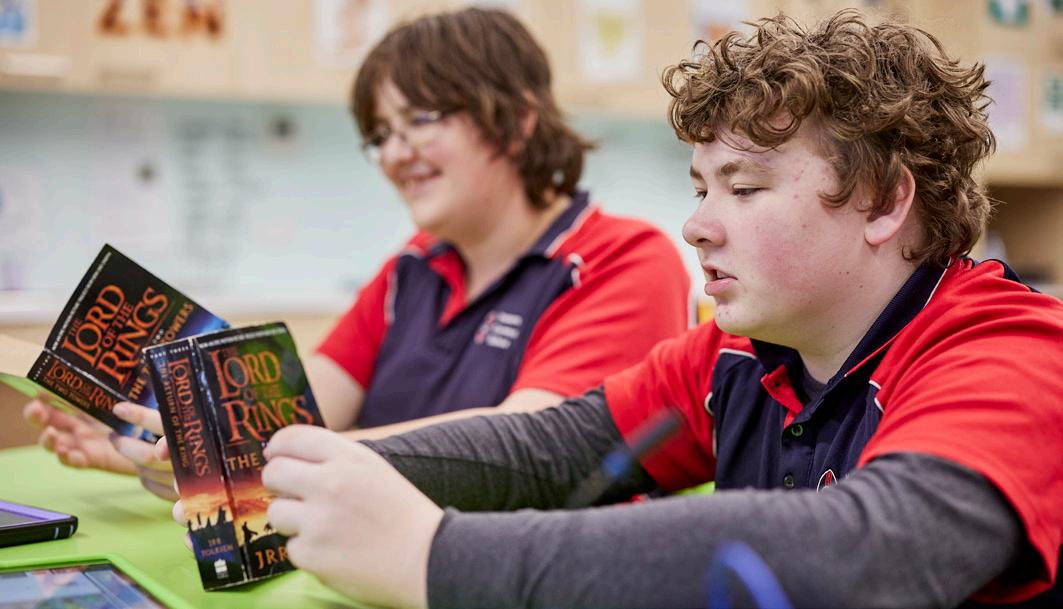
From boys to men – using literature circles to explore Year 8 boys’ perceptions of masculinity
 Pooja Mathur Teacher Librarian, the King’s School
Pooja Mathur Teacher Librarian, the King’s School
Pooja Mathur shares her action research into the use of literature to encourage students’ exploration and expansion of their perceptions of masculinity.
This article describes an action research project involving sixteen boys from a Year 8 mixed-ability English class in a metropolitan boys’ high school. Based on my experience as a teacher librarian and research that suggests analysing contemporary Australian literature portraying a range of masculine characters and attitudes offers an effective means to explore and analyse concepts of masculinity (Garrison et al., 2021; Potter, 2007 ), my research question was: How can participation in literature circles in a Year 8 English class evolve boys’ perceptions of masculinity?
Mills (2018) notes that action research is any systematic inquiry conducted by educators in their particular context to gain insight, develop reflective
40 Scan Vol 43 Issue 2
practice and effect positive change. In achieving these aims, the educational outcomes for their students are enhanced. The cyclical approach of practical action research – planning an action, collecting, and analysing data, drawing conclusions and reflecting on them – is underpinned by a commitment to ongoing professional development and assumes that the teacher-researcher has agency to determine the research topic and the way the research is conducted (Mills).
Given the practical nature of action research and its potential to amplify my educational experience and that of my students, it was an appropriate methodology on which to build my exploration of the use of literature to promote my participants’ exploration of, and reflection on, the notion of masculinity. Action research enabled me to strengthen and improve the teaching-learning process and support new and improved modes and models of delivering instruction that engaged my students and promoted their critical thinking.
The sixteen boys participated in a suite of pre- and post-action literature-based activities that included quizzes, surveys, written reflections, artistic and photographic responses, and multiple sessions of structured and unstructured literature circles. During these activities, the boys were encouraged to reflect on and share their understandings of masculinity, dissect numerous masculine stereotypes, and list and reflect on various agencies influencing their perceptions of masculinity. My research findings indicate that literature circles encouraged candid, insightful and honest discussions amongst the boys regarding their perceptions of masculinity and had the potential to assist in shattering stereotypes and helping boys cultivate notions of healthy masculinity.
... literature circles encouraged candid, insightful and honest discussions amongst the boys regarding their perceptions of masculinity and had the potential to assist in shattering stereotypes and helping boys cultivate notions of healthy masculinity.
The study of potentially controversial issues is acceptable for educational purposes providing resources and activities align with the NSW curriculum. When selecting texts or engaging students in work around controversial issues, teachers should refer to the Controversial issues in schools policy (NSW Department of Education, n.d.).
Literature review
‘He wears a mask, and his face grows to fit it’ (Orwell, 1936, para 7 ).
Masculinity – moving forward
Over centuries, and across the world, the concept of ‘hyper masculinity’ – the exaggeration of masculine stereotypes (Arundev, 2023) – has prevailed in many societies. This notion of masculinity, understandably much contested and variously refined, continues to be perpetuated via social media (Ging, 2019), family traditions, societal expectations, and even educational institutions. Young men often find themselves boxed into predetermined sets of attributes (Hill et al., 2020) that are increasingly at odds with today’s world, where equality of genders, self-realisation and celebration of positive masculinity are of paramount importance ( Wilson et al., 2021).
The Orwellian quote cited earlier rings ominously true when examined via the social constructivist lens of various masculinity-based studies (Carroll et al., 2019; Murnen, 2015), highlighting that once a person begins to conform to expectations and pressures- to proclaim their toughness, superiority, and perfection, the ‘mask’ becomes an integral part of their identity (Edwards and Jones , 2009) and often results in mental health issues over time (Rice et al., 2011).
For boys and young men, the journey to ‘becoming a man’ (Edwards, 2022) is fraught
41 Scan Vol 43 Issue 2
with challenges and pitfalls. Research (Jesuit Social Services, 2020) titled Unpacking the Man Box (PDF 3.7 MB), however, highlights that unpacking the set of societal beliefs that place pressure on men to act in a certain way can have a positive impact on the attitudes of young men faced with negative messaging about masculinity and manhood. Furthermore, the evolving research regarding the concept of ‘positive masculinity’ (McDermott et al., 2019; Wilson, 2022; Wilson et al., 2021) and the impact on mental health of young boys and men having to conform to traditional gender norms (Rice et al., 2021) highlights the need to shift the conversation from a recurring discussion of ‘toxic masculinity’ (Harrington, 2021) to the exploration and celebration of positive masculinity.
The power of literature
Literature has the capacity to reflect human lives and experiences by providing windows, mirrors, and sliding doors (Sims Bishop, 1990, PDF 762 KB). When students see themselves reflected in relatable characters dealing with real-life scenarios, they gain an insight into personal issues and are prompted to contemplate and envision possible solutions. Additionally, literature allows students to see others’ perspectives and to vicariously step into others’ shoes.
Garrison et al. (2021) focus on the depiction of various masculine traits in four award-nominated Australian young adult novels. The researchers endeavored to investigate ‘how masculinity is represented to young people through their literature’ (p 254) to gain some perspective into the impact of such messages on readers’ contemplation and opinions regarding masculinity and ‘being a man’. Most importantly, Garrison and colleagues underlined the paucity of, and immediate need for, contemporary Australian research showcasing the ‘voice of young readers and examine how they respond to these books using these lenses’ (p 253). My action research project was thus informed, prompted, and guided by the call-to-arms that emerged from such research.
Literature circles
Literature circles are a pedagogic approach that harnesses the educational value and power of student-directed discussions based on a literary text a group has read (Herrera and Kidwell, 2018).
According to Boudreau (2021), literature circles are tried and tested, and remain popular since they are ‘incredibly effective’ (para 4). Boudreau elaborates, that various studies accentuate the ‘positive impact’ (para 4) of peer-group discussion based on the books students read. Such exchanges encourage critical thinking skills and stimulate deeper understanding of the plot and characters from the perspective of a peer and create connections between fiction and students’ own realities.
Through the use of classroom strategies such as literature circles, educators can nurture students’ inherent need to prove themselves as independent learners ( Vaughn, 2018) and assist them to develop essential twenty-first century skills, such as participating meaningfully in collaborative learning (Child and Shaw, 2016, PDF 273 KB).
Essentially, literature circles consist of independent reading of the same material, followed by structured student-led discussion in collaborative small groups and guided by reader response principles (Irawati, 2016). Students are encouraged to share their responses to the text as reflective of their personal experiences and background knowledge. Additionally, the various roles students play during literature circles generate ‘a new level of accountability and engagement’ (Kraiter, 2017, p 41, PDF 2.2 KB), along with autonomy over their
When students see themselves reflected in relatable characters dealing with real-life scenarios, they gain an insight into personal issues and are prompted to contemplate and envision possible solutions. Additionally, literature allows students to see others’ perspectives and to vicariously step into others’ shoes.
42 Scan Vol 43 Issue 2
learning amongst the group members. Roles may be labelled attractively; for example, Discussion Director, Literary Luminary, Connector, Illustrator, Summariser and so forth ( Turk, 2023). These roles are rotated amongst the group members at each session, where participation and the sharing of ideas and thoughts are keys to a successful literature circle (Copper, 2020).
Participants and ethics
My research participants were 16 students from a Year 8 (13-14-year-old-boys) mixed-ability English class. The boys came from diverse ethnic, racial and religious backgrounds.
The rights of the students participating in the research were protected throughout and beyond the research. As per Mertler’s (2020) principles of honesty and accurate disclosure, students and their parents were provided with clear and complete information regarding the purpose, time frame, research methods, reporting, and presentation of the research findings. Consent to participate and be interviewed, photographed, and videoed was obtained from parents and students via written/digital information letters and consent forms. It was made clear that the students’ identities would be protected in the dissemination of the research findings, participation in the project was voluntary, and students and/or parents could withdraw their consent at any point. No students were disadvantaged by participating, or not participating, in this research.
Collected data were kept secure and confidential in digital format, uploaded into secure, password protected cloud-based storage.
The action
The text selected for the research was Mallee Boys by Charlie Archbold (2017). It was the winner of the 2016 Adelaide Festival Unpublished Manuscript Award and Honour Book in the 2018 Children’s Book Council of Australia (CBCA) ‘Book of the Year for Older Readers’ Award.
Through the boys’ reading of Mallee Boys and participation in pre- and post-reading activities (including several sessions of literature circles, group discussions, questionnaires, and relevant
reflection activities), I aimed to determine whether the participating students’ pre-conceived and evolving notions regarding masculinity were challenged and whether the action assisted boys to cultivate notions of healthy masculinity.
After conducting pre-action activities, I implemented two sessions of traditional literature circles, two of modified literature circles, and one non-structured peer-interview/discussion session. Initially, I had not anticipated that there would be a need to modify or veer away from traditional literature circle roles; however, I realised that modified roles would extend literature circles for further in-depth and personalised peer-discussions. Additionally, I decided to experiment further with the final session by making it completely unstructured, giving the students full freedom and flexibility during the discussion.
The modified literature circles involved the boys being given the role of prominent characters in the book and a list of prompts and questions that would help them unpack the characters’ actions and motivations. In the unstructured session, there were no roles, just prompts from various related activities that boys could pick and use to start a conversation.
I planned and conducted the research from August to December 2022. Each student received a copy of Mallee Boys and was encouraged to read the entire novel of some 200 pages. In Term 4 (midOctober to early December 2022), I worked with the students weekly to implement literature circles and gather data.
Data collection
My research question was focused on the exploration of literature to evolve boys’ perceptions of masculinity. To ‘evolve’ is to develop gradually, with the key to determining whether a concept or idea has evolved being to check regularly and chart the growth and/or changes (if any). I collected qualitative and quantitative data through various methods.
I commenced my research by inviting the boys to share, via a Likert scale questionnaire, what they classified as male or female household chores and responsibilities. Subsequent activities required
43 Scan Vol 43 Issue 2
the boys to create work samples by locating and placing themselves into their family’s story-quilt, submit ‘selfless selfies’ to depict how they see themselves without having their face or physique in the photo, provide Padlet responses regarding masculine stereotypes, and fill in a questionnaire titled Masculinity: your thoughts, which explored their perceptions of various aspects of masculinity. These data provided a benchmark from which to explore any movement in the boys’ perceptions of masculinity facilitated through the literature circles.
During the literature circle sessions, I collected illustrator’s drawings and participant notes, and made audio and video recordings of each session.
Data analysis
I transcribed the recordings of the recorded literature circle sessions and, using an inductive approach, analysed the transcripts to identify codes. I added all codes to a spreadsheet and after debating over a semantic or latent approach, I adopted the latter as I wished to investigate what my students’ words and thoughts revealed about their assumptions of masculinity within their social context over the period of action research interventions. I then identified, reviewed and refined themes. Furthermore, I dedicated considerable time to polyangulating the quantitative data (Likert scale questionnaire responses) with the suite of qualitative data to ensure the credibility and trustworthiness of findings (Mertler, 2020).
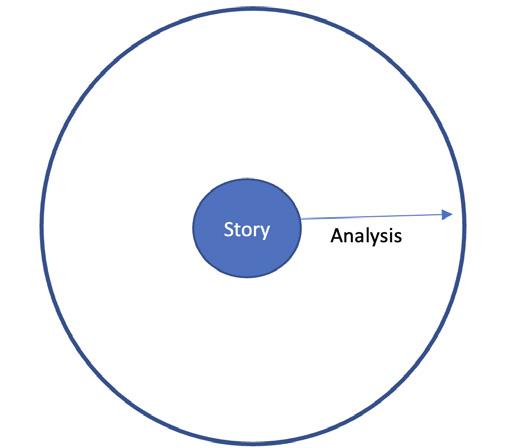
Results and discussion of findings
My phenomenological approach to this action research was to plan and implement literature circles (and supporting activities) for my students to allow them to organically reflect on, discuss and update (if required) their perceptions of masculinity.
Three sequential themes were identified in my analysis, the first leading to the next and so on. I used the metaphor of a circle (referring to literature circles) to frame my findings and designed diagrams for visual representation. The focus of the literature circles was the analysis of the plot and characters of Mallee Boys. This prompted the boys to have deep, targeted conversations (radius), leading to development of personal connections and sharing of experiences (diameter), which further lead to reflection, deeper understanding, and evolved perspectives of masculinity (circumference).
Literature-based discussion prompts conversations about boys’ perceptions of masculinity
The focus, or center point of our literature circles, was the plot or story of Mallee Boys revolving around Dad, Red, Sandy, Ryan, and other characters. The boys’ analysis of various masculinities depicted and personified by the male characters of the novel and understanding their motivations and interpersonal relationships, can be considered as the radius of the literature circles (see Figure 1).
Students analysed each character minutely and drilled deeper into the type of masculinity they represented. One student remarked, ‘Red is associated with people who think that men should always be hostile and repress their emotions essentially’, while another added, ‘stereotypically boys keep to themselves and try to hide their emotions ‘cause they are scared of other people’s reactions’. The boys were thus able to identify that males can be emotional and vulnerable (Reiner, 2021) but feel compelled to hide their true feelings (Clark, 2016).
44 Scan Vol 43 Issue 2
Figure 1: Analysis – the radius of the literature circle
One of the boys described his drawing of a main character as:
Crying inside, but like he has [a] mask on, holding back tears, [he] has pain in his heart— he was not free to show it to the public, yeah, [he] kept it to himself like a mask ... [it] highlights the stereotype that men shouldn’t actually cry.
The boy’s words demonstrate that he understood the character’s dilemma to remain stoic and not display emotion, which is often expected by society. Another student’s observation that, ‘Instead of calling [the] police, Red confronted Ryan – like people would expect men to do’, further suggested that the students were able to recognise and identify motivations driving the male characters’ behaviour and choices – to be considered brave and ‘manly’, not weak.
While discussing the author’s motivation behind the novel, one of the boys summed up everyone’s feelings succinctly: ‘Her [the author’s] entire motif is basically like counteracting against the stereotypes of masculinity.… I think maybe she’s just, like, sick of society wanting men to behave like this’. From such comments, it is evident that literature circles effectively encouraged critical thinking skills and stimulated deeper understanding of plot and characters (Boudreau, 2021) and the boys’ perceptions of masculinity.
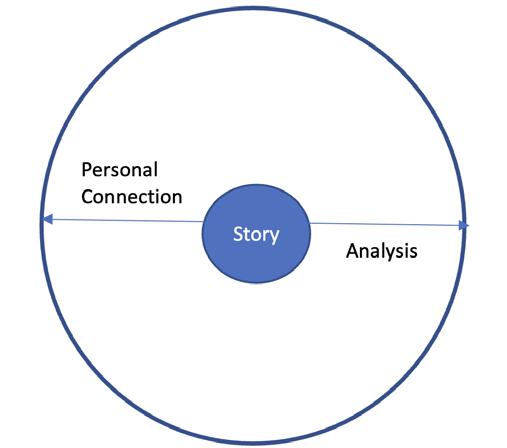
Shared stories create personal connections and reflection on masculinity
Honest and open analysis of the novel’s characters and their various masculinities flowed naturally into the students establishing personal connections by sharing their own experiences. The diameter of the literature circles can be measured by the frank and courageous conversations that the boys dived into while recounting family expectations and other influences that shape them as males (see Figure 2).
One of the boys, identifying with Sandy, observed, ‘I think I would have reacted similarly to Sandy ... Sandy shows tender masculinity, he was very quiet’. Another student added, ‘To me Sandy sort of represents the least traditional masculinity, meaning less like how modern society and popular media portrays masculinity’, while another declared, ‘I fit between, like a midpoint between Sandy and Red’.
As the boys reflected on their class’ Padlet entries on masculine stereotypes (see Figure 3), a student proclaimed, ‘I think, right now because of the Internet and Andrew Tate, there is definitely more of the “men need to be muscular, men are superior” thing going round’. Another student added, ‘We are peer pressured into thinking that ... I mean it’s like society is deciding what we want for us’. These observations demonstrate that literature circle discussions facilitated the boys’ reflections on the way contemporary popular media and society affect them personally.
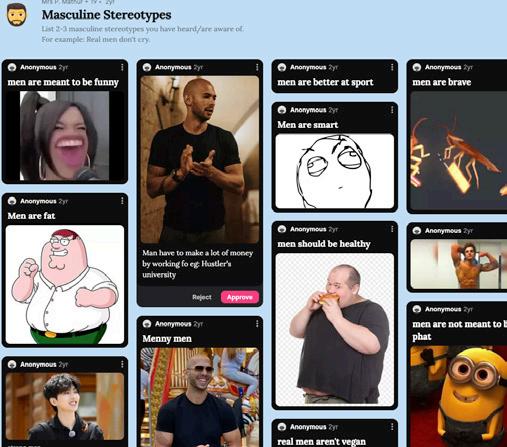
45 Scan Vol 43 Issue 2
Figure 2: The diameter of literature circles
Figure 3: Padlet responses on masculine stereotypes
Pre-action data indicated that most boys and their families adhered to a traditional patriarchal family set-up, which influenced their attitudes and perceptions of masculinity. Furthermore, the boys were aware of conventional masculine traits as well as those highlighted and propagated by family members, friends, society, social media, and other influences (Rice et al., 2021).
To this end, one of the boys mused:
I find every parent has, like a different view of what their son should grow up to be ... the main stereotype in general is that, like, men are expected to, like, stand up for themselves and to always, like, hide their true emotions in front of everyone else, yeah, put on this confident façade.
This comment, plus similar others, indicate that literature circle discussions assisted students to create connections between fictitious characters and their own realities as they participated meaningfully in collaborative learning (Child and Shaw, 2016).
Personal connection and reflection results in deeper understanding and evolved perspectives of masculinity
The circumference of the literature circles can be represented by a deeper understanding of masculinities gained through analysis of Mallee Boys, while establishing personal connections during honest peer-led discussions – potentially leading to evolved perspectives (see Figure 4).

... literature circle discussions assisted students to create connections between fictitious characters and their own realities as they participated meaningfully in collaborative learning.
During literature circle discussions, a boy mused ‘Mallee Boys, like, assures us that real men don’t have to fit into all these stereotypes, and how they can choose, like their own path, and how we don’t have to adhere to what society thinks of us’. Another confessed, ‘My parents keep telling me that men, like, have to provide for the family, they must be wealthy and successful but, I kinda feel like I have to differ from that point’. Yet another student summed up his personal connection and observations:
I fit between, like a midpoint between Sandy and Red because I feel like I’m not overly submissive but I’m also not like overly hostile in my behaviour ... I think it’s good that Sandy has his own personality, he doesn’t fit into many stereotypes, he’s being different and it’s just nice to read something different from stereotypes, you know.
It was evident that literature circle discussions encouraged the boys to share their responses to the text as reflective of their personal experiences and background knowledge (see Figures 5, 6 and 7) and, to a noticeable extent, showcased the boys’ evolving notions regarding masculinities. Several boys questioned and even criticised the traditional notions of masculinity, while displaying growth and maturity in their own perception of modern masculinity.
Overall, most of the boys recognised and succinctly listed family and societal expectations, reflected on their stance, and several boys displayed a new understanding of masculinity. Reading the novel and identifying and empathising with the characters were the stimuli to digging deeper and connecting and sharing personal experiences (Gabriel, 2022), while exploring and expanding their perspectives regarding masculinity.
46 Scan Vol 43 Issue 2
Figure 4: The circumference of literature circles
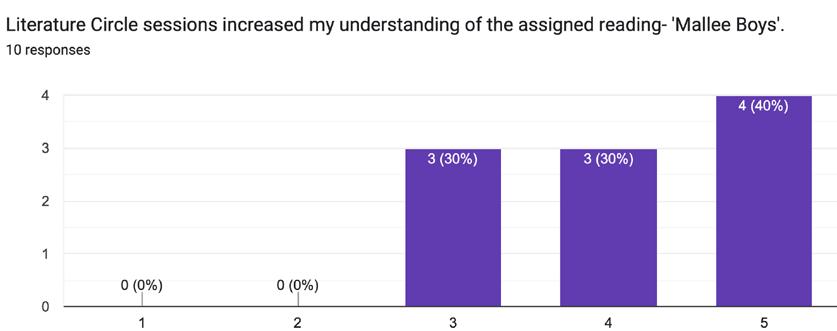
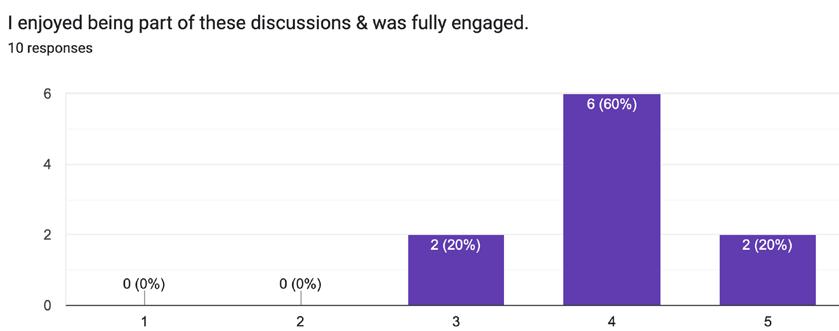
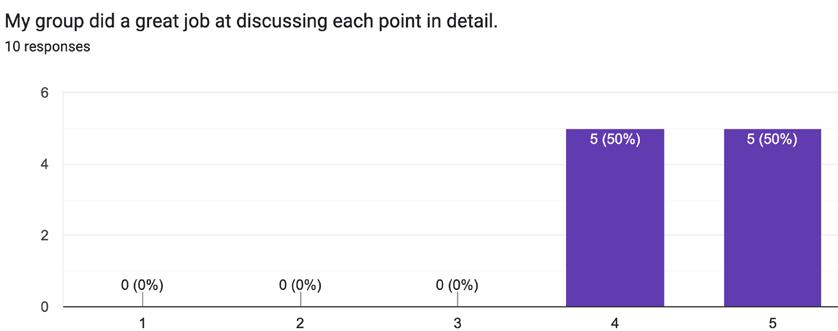
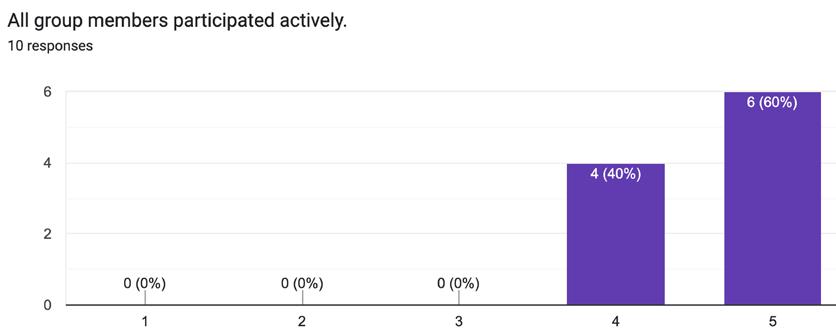
47 Scan Vol 43 Issue 2
Figure 5: Reflections on literature circle participation
Figure 6: Effectiveness of literature circles

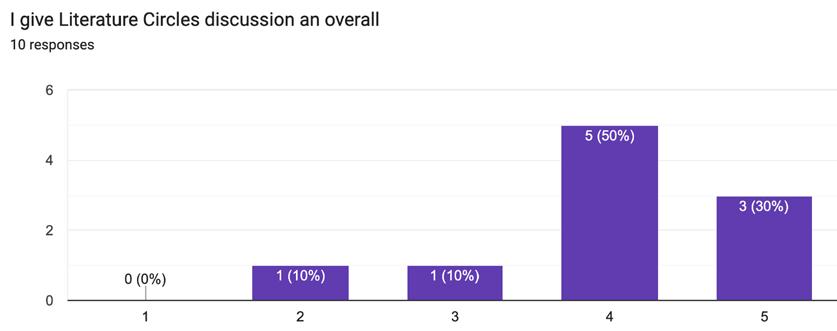
Conclusions and implications
Reading Mallee Boys, along with participating in preand post-reading activities – especially peer-led, honest, and reflective discussions during literature circles – assisted participating boys to reflect on:
• the types of masculinities they grew up surrounded by
• the kind of masculinity they are expected, and often coerced, into adopting and displaying
• the kind of man they aspire to be and any disparities between the familial and societal expectations and their own evolving perspectives of masculinity.
In presenting my research findings, I am conscious of the parameters of this action research project. With only 16 participants and the relatively short duration of the project, the research data and findings are not sufficient to make the broad claim that reading novels and participating in literature circles and related activities can be instrumental in shattering stereotypes and helping boys cultivate notions of healthy masculinity.
However, the generalisabilty of research findings or the generation of theory are not aims of action research; rather, the aim is to improve understanding and practice in a particular context (Mills, 2018), which I did achieve. As Mills notes, ‘the power of action research is not in its generalizability. It is the relevance of the findings to the researcher or the audience of the research’ (p 162).
With this initial cycle of action research, I had hoped to facilitate awareness about the ‘mask’ (Edwards and Jones, 2009) regarding societal expectations shaped around masculinity and give boys an
Reading the novel and identifying and empathising with the characters were the stimuli to digging deeper and connecting and sharing personal experiences (Gabriel, 2022), while exploring and expanding their perspectives regarding masculinity.
48 Scan Vol 43 Issue 2
Figure 7: Effectiveness of, and satisfaction with, literature circles
opportunity to question the validity of these expectations by gaining new perspectives. To this end, the action of using literature to promote discussion of, and reflection on, notions of masculinity did encourage the participating boys to critically examine and expand their stance on masculinity. In the future, I look forward to expanding and integrating this action research
References
Archbold, C. (2017). Mallee boys. Wakefield Press.
Arundev, V. R. (2023). The interrelationship between hyper-masculinity and urbanity: A study on the alpha male characters in Malik. Postscriptum: An Interdisciplinary Journal of Literary Studies, 8 (i). https://doi.org/10.5281/zenodo.8400440
Boudreau, E. (2021, November 12). Literature circles. Harvard Graduate School of Education.
Carroll, J.-A., Capel, E. M. & Gallegos, D. (2019). Meat , masculinity, and health for the “typical Aussie bloke”: a social constructivist analysis of class, gender, and consumption. American Journal of Men’s Health, 13 (6). https://doi.org/10.1177/1557988319885561
Child, S. & Shaw, S. (2016). Collaboration in the 21st century: implications for assessment (PDF 273 KB)
Copper, J. (2020, May 28). How to facilitate awesome literature circles in secondary ELA
Edwards, K. E. (2022). Becoming a man: a longitudinal study of men’s gender identity development. Journal of College Student Development, 63 (2), 185–199. https://doi. org/10.1353/csd.2022.0014
Edwards, K. E. & Jones, S. R. (2009). “Putting my man face on”: a grounded theory of college men’s gender identity development. Journal of College Student Development, 50 (2), 210–228. https://doi. org/10.1353/csd.0.0063
project within my school’s existing ‘Boys to Men’ program across multiple year groups.
Acknowledgement : This action research project was conducted as part of the International Boys’ Schools Coalition’s (IBSC) Action Research Program. Thanks go to the IBSC and The King’s School for their support.
Gabriel, E. (2022, June 3). Why sensitivity is a strength in boys Greater Good Magazine
Garrison K., Mary M. & Derouet, E. (2021). Of men and masculinity: the portrayal of masculinity in a selection of award-winning Australian young adult literature. Knygotyra, 76, 228–259. https://doi. org/10.15388/Knygotyra.2021.76.82
Ging, D. (2019). Alphas, Betas, and Incels: theorizing the masculinities of the manosphere. Men and Masculinities, 22(4), 638–657. https://doi. org/10.1177/1097184X17706401
Harrington, C. (2021). What is “toxic masculinity” and why does it matter? Men and Masculinities, 24 (2), 345–352. https://doi. org/10.1177/1097184X20943254
Herrera, L. J. P. & Kidwell, T. (2018). Literature circles 2.0: updating a classic strategy for the 21st century. Multicultural Education, 25(2), 2.
Hill, A. L., Miller, E., Switzer, G. E., Yu, L., Heilman, B., Levtov, R. G., Vlahovicova, K., Espelage, D. L., Barker, G. & Coulter, R. W. S. (2020). Harmful masculinities among younger men in three countries: psychometric study of the Man Box Scale. Preventive Medicine, 139, 106185–106185. https://doi.org/10.1016/j.ypmed.2020.106185
Irawati, D. (2016). Effectiveness of literature circles on students’ reading comprehension. Indonesian Journal of Language Teaching and Linguistics, 1(3), 179–192. https://doi.org/10.30957/ijoltl.v1i3.183
49 Scan Vol 43 Issue 2
Jesuit Social Services. (2020, July 21). Unpacking the Man Box: what is the impact of the Man Box attitudes on young Australian men’s behaviours and wellbeing? (PDF 3.7 MB)
Kraiter, S. C. (2017). Literature circle modules in the high school classroom and their effect on student engagement (PDF 2.2 MB). Southwestern University.
McDermott, R. C., Pietrantonio, K. R., Browning, B. R., McKelvey, D. K., Jones, Z. K., Booth, N. R. & Sevig, T. D. (2019). In search of positive masculine role norms: testing the positive psychology positive masculinity paradigm. Psychology of Men & Masculinity, 20 (1), 12–22. https://doi.org/10.1037/ men0000160
Mertler, C. A. (2020). Action research: Improving schools and empowering educators (6th ed.). Sage.
Mills, G. (2018). Action research: A guide for the teacher researcher (6th ed.). Pearson.
Murnen, S. K. (2015). A social constructivist approach to understanding the relationship between masculinity and sexual aggression. Psychology of Men & Masculinity, 16 (4), 370–373. https://doi.org/10.1037/a0039693
New South Wales Department of Education. (n.d.). Controversial issues in schools
Orwell, G. (1936). Shooting an elephant. The Orwell Foundation.
Potter, T. (2007). (Re)constructing masculinity: representations of men and masculinity in Australian young adult literature. Papers: Explorations into Children’s Literature, 17(1), 28–35. https://doi.org/10.21153/pecl2007vol17no1art1203
Rice, S., Fallon, B. & Bambling, M. (2011). Men and depression: the impact of masculine role norms throughout the lifespan. The Australian Educational and Developmental Psychologist, 28 (2), 133–144. https://doi.org/10.1375/aedp.28.2.133
Rice, S., Oliffe, J., Seidler, Z., Borschmann, R., Pirkis, J., Reavley, N. & Patton, G. (2021, August). Gender norms and the mental health of boys and young men. The Lancet Public Health, 6 (8), e541–e542. https://doi.org/10.1016/S2468-2667(21)00138-9
Sims Bishop, R. (1990). Mirrors, windows, and sliding glass doors (PDF 762 KB)
Turk, J. K. (2023). Literature circles promote accountability and student engagement with assigned reading in a soil science class. Natural Sciences Education, 52(1). https://doi.org/10.1002/ nse2.20103
Vaughn, M. (2018, March 26). Making sense of student agency in the early grades. Phi Delta Kappan, 99 (7), 62–66. https://doi. org/10.1177/0031721718767864
Wilson, M. J. (2022). Cultivating positive masculinity is mental health promotion for boys and men. Health Promotion International, 37(4). https://doi. org/10.1093/heapro/daac121
Wilson, M., Gwyther, K., Swann, R., Casey, K., Featherston, R., Oliffe, J. L., Englar-Carlson, M. & Rice, S. M. (2021, April 11). Operationalizing positive masculinity: a theoretical synthesis and schoolbased framework to engage boys and young men. Health Promotion International, 37(1). https://doi. org/10.1093/heapro/daab031
How to cite: Mathur, P. (2024). From boys to men: using literature circles to explore Year 8 boys’ perceptions of masculinity. Scan, 43(2), 40–50.
50 Scan Vol 43 Issue 2
The journal for educators
Writer biographies

Jade Arnold
Jade Arnold is the Premier’s Program Officer, Reading and Spelling, overseeing the Premier’s Reading Challenge and Premier’s Spelling Bee. Jade started her teaching career as an English and history teacher but retrained as a teacher librarian after seeing the devastating impact the loss of her school’s library to fire had on her students. She is an avid reader of young adult fiction and is passionate about engaging teenagers in reading for leisure.

Dr Mark Howie
Mark Howie (EdD) is Leader, Writing in Secondary, Quality Teaching Practice. He has been a teacher and head teacher of English, deputy principal and principal. Mark is an Adjunct Fellow with the School of Education at Western Sydney University and a former President of both the Australian Association for the Teaching of English and the English Teachers Association NSW. His teaching awards include the NSW Minister’s Award for Excellence in Teaching (2000) and Highly Commended (for Excellence by a Teacher) in the Australian Government National Awards for Quality Schooling (2008).

Brodie Jones
Brodie Jones now teaches design and technology at St Joseph’s Catholic High School. Throughout her career, Brodie has employed and designed student-centred pedagogy frameworks, developing subject knowledge while explicitly fostering students’ understanding of learning strategies, metacognitive skills, self-regulation and self-awareness for autonomous learning. With postgraduate qualifications in gifted education, Brodie has also contributed to HPGE leadership, delivering professional learning on strategies for fostering creative thinking and neurodiversityaffirming practices.
51 Scan Vol 43 Issue 2
The journal for educators
Writer biographies

Daniel Jones
Daniel Jones is a teacher librarian. As a former professional artist and visual arts teacher, ongoing technology and learning psychology enthusiast, prioritiser of engagement, purpose and discovery over academic achievement, and an adult diagnosed ADHDer, Daniel has thoroughly learnt the value of creativity, innovation, risk taking, empathetic communication and scaffolded organisation. Daniel curates a range of resources at the Smith’s Hill High School Library, including many celebrating neurodiversity and supporting neurodivergent students.
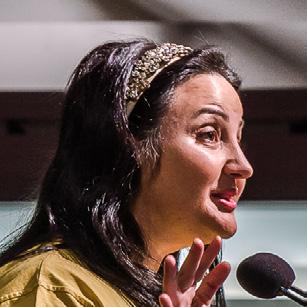
Katie Koullas
Katie is the passionate creator and CEO of Yellow Ladybugs – an autistic-led charity dedicated to supporting autistic girls, women, and gender diverse individuals. Katie has presented at many conferences, been nominated for Australian of the Year for her advocacy, and has worked hard to create systemic change with state and federal governments to better support neurodivergent individuals. Despite a rich and varied career, Katie’s favourite role has been working alongside her neurodivergent team, helping Yellow Ladybugs grow to maximise its positive impact.
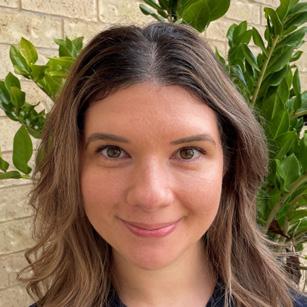
Dr Angelina Leonello
Angelina Leonello is an Evaluation Capacity Building Lead in the Quality Teaching Practice Evaluation and Data team. She has a PhD in cognitive psychology and is passionate about ensuring that people have the knowledge and skills to make datadriven decisions that advance educational opportunities for all learners in NSW. She is on a mission to improve data literacy, one pivot table at a time.
52 Scan Vol 43 Issue 2
The journal for educators
Writer biographies
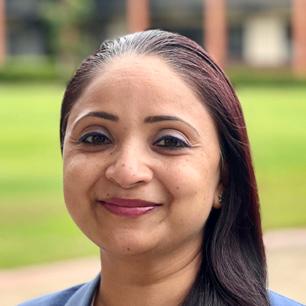
Pooja Mathur
Pooja Mathur is a teacher librarian at The King’s School Senior Library and coordinator of its Reading Club. She was the recipient of the Australian School Library Association’s 2023 Early Career Teacher Librarian Award. Pooja strongly believes in students’ voice and choice: that self-selected wide reading promotes mental health and well-being, empathy, and literacy. In 2024, she is undertaking a Graduate Certificate in Arts and Social Science Research through Charles Sturt University, focusing on Australian young adult multicultural literature.

Caitlin Morton
Caitlin Morton is an Evaluation Lead in the Quality Teaching Practice Evaluation and Data team. She has a background in social research and policy and is passionate about driving social change with evaluation and research. Caitlin leads a team to create innovative evaluation solutions to solve complex problems and ensure policy and strategy decisions are based on strong data and evidence to strengthen public education in NSW.
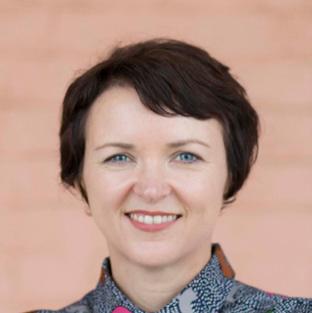
Tanya Notley
Tanya Notley is Associate Professor in the School of Humanities and Communication Arts and a member of the Institute for Culture and Society at Western Sydney University. Her research and teaching focus on the social and cultural impact of communication technologies. She collaborates with cultural institutions, education providers and social justice organisations in the areas of media literacy and digital inclusion. Dr Notley also served as the Co-Chair of the Australian Media Literacy Alliance (AMLA) between 2019-2023.
53 Scan Vol 43 Issue 2
The journal for educators
Writer biographies

Chris Varney
Chris Varney is the Founder and CEO of I CAN Network, Australia’s largest Autisticled organisation. I CAN is helping more than 3,000 neurodivergent young people develop self-confidence, optimism and a sense of belonging through shared experiences with peers and mentors in school-based and national online mentoring programs. Chris also serves as National Patron of the Australian Association for Special Education and is the Chairperson of the Victorian Disability Advisory Council.
54 Scan Vol 43 Issue 2

Want more innovative ideas and inspiration for learning and teaching?
Browse our past issues – a compendium of educational ideas to enhance your teaching practice.
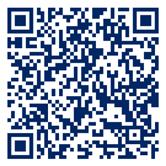




















 Tanya Notley Associate Professor, University of Western Sydney
Tanya Notley Associate Professor, University of Western Sydney




 Katie Koullas CEO, Yellow Ladybugs
Katie Koullas CEO, Yellow Ladybugs

 Chris Varney Founder and CEO, I CAN Network
Chris Varney Founder and CEO, I CAN Network























 Pooja Mathur Teacher Librarian, the King’s School
Pooja Mathur Teacher Librarian, the King’s School





















